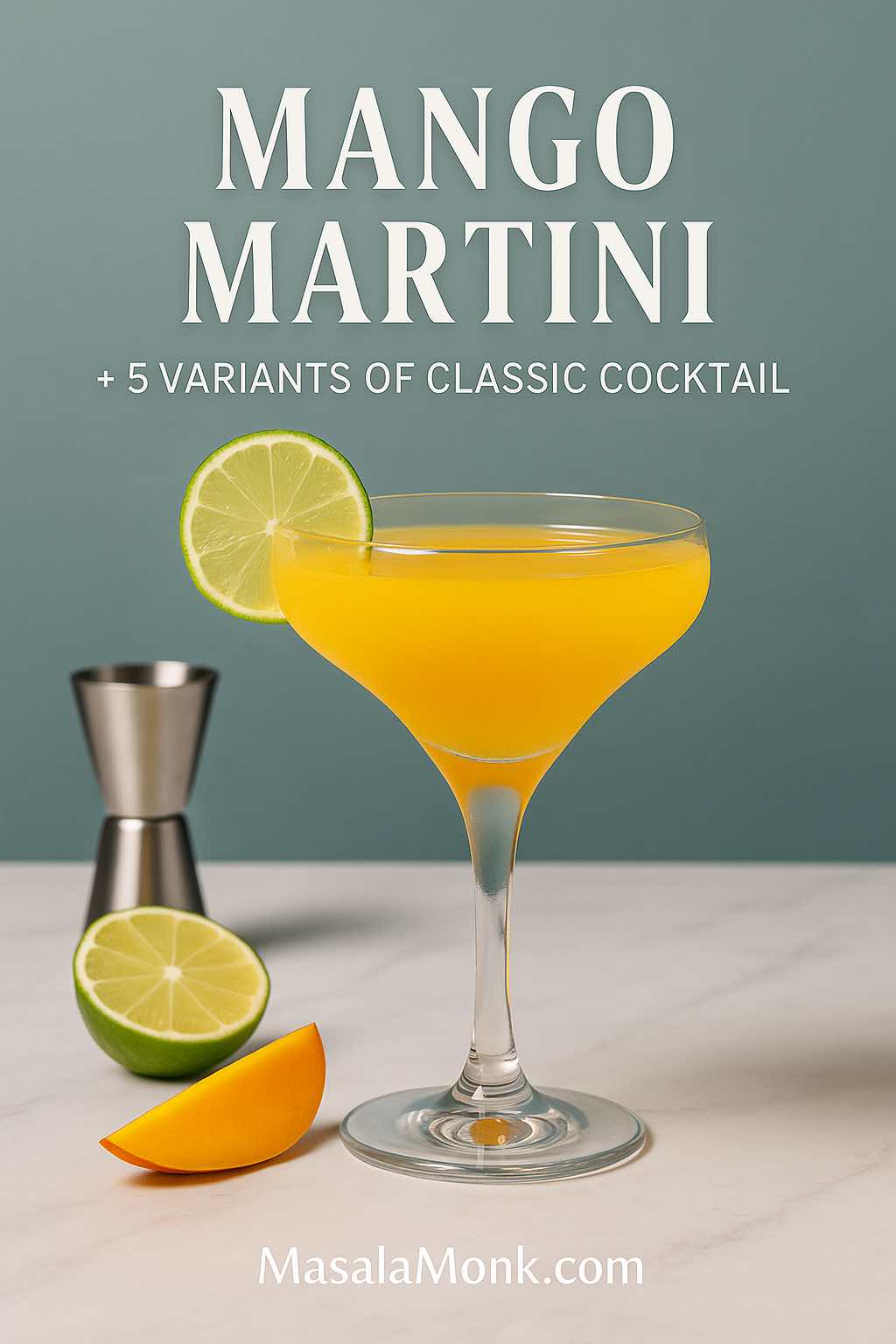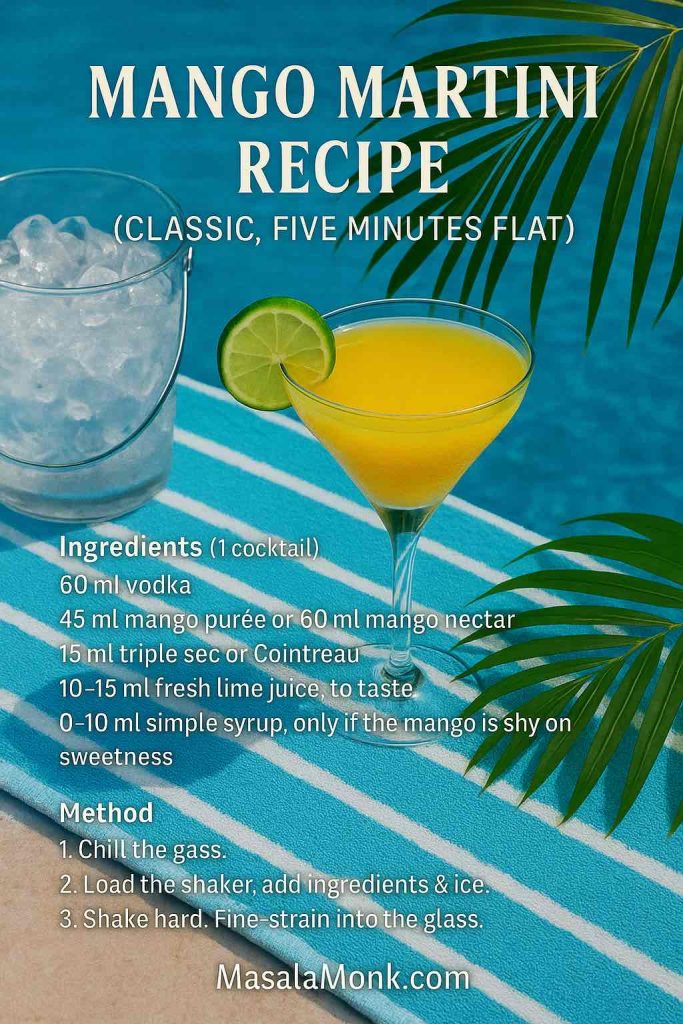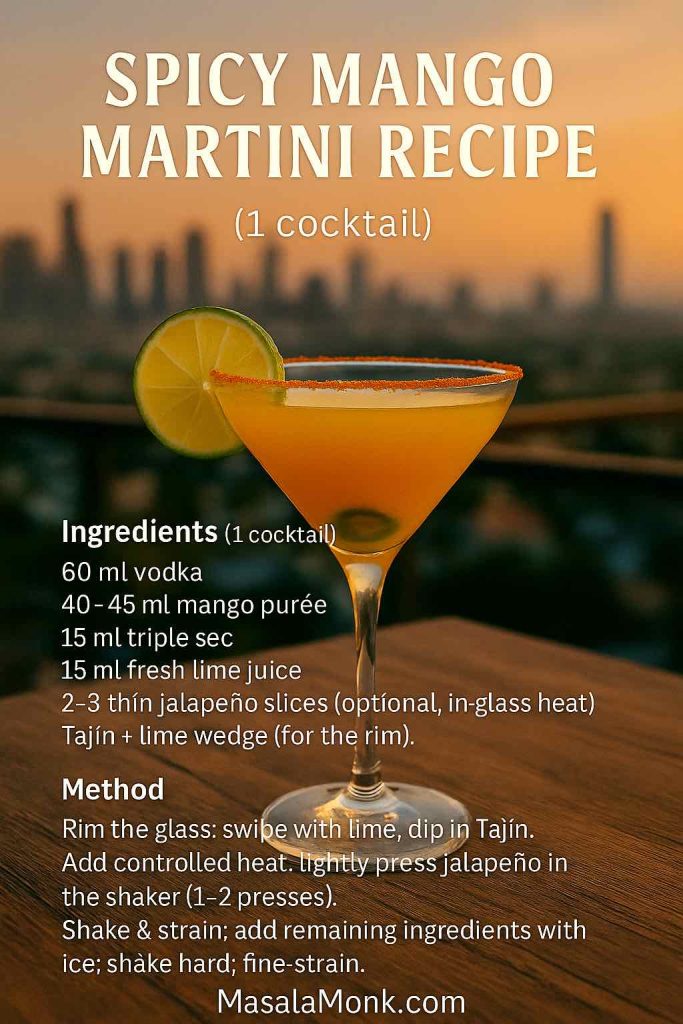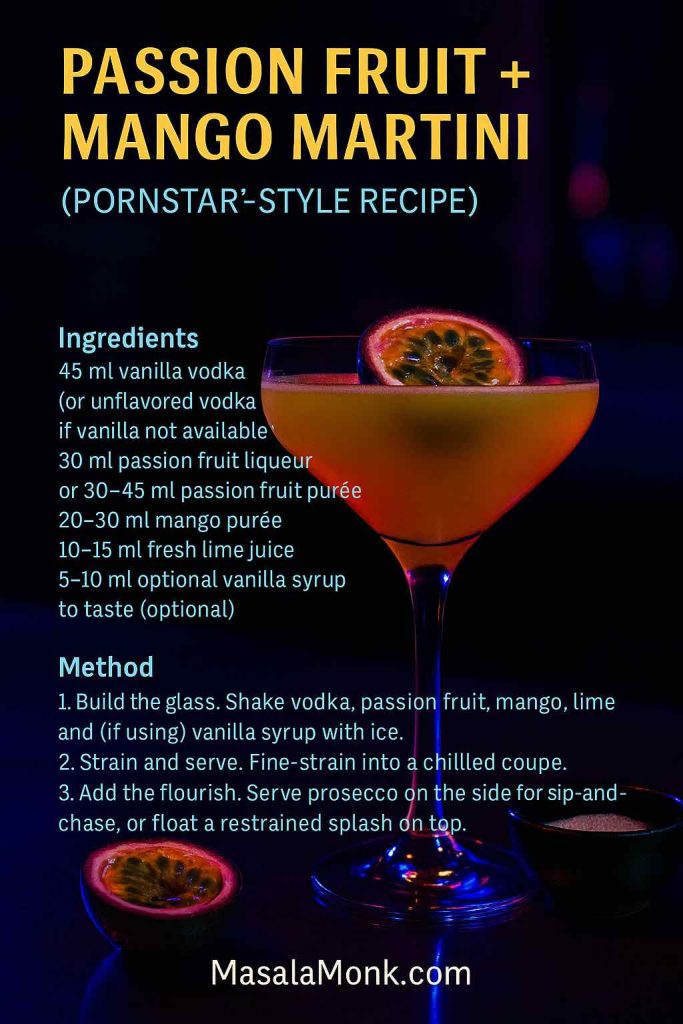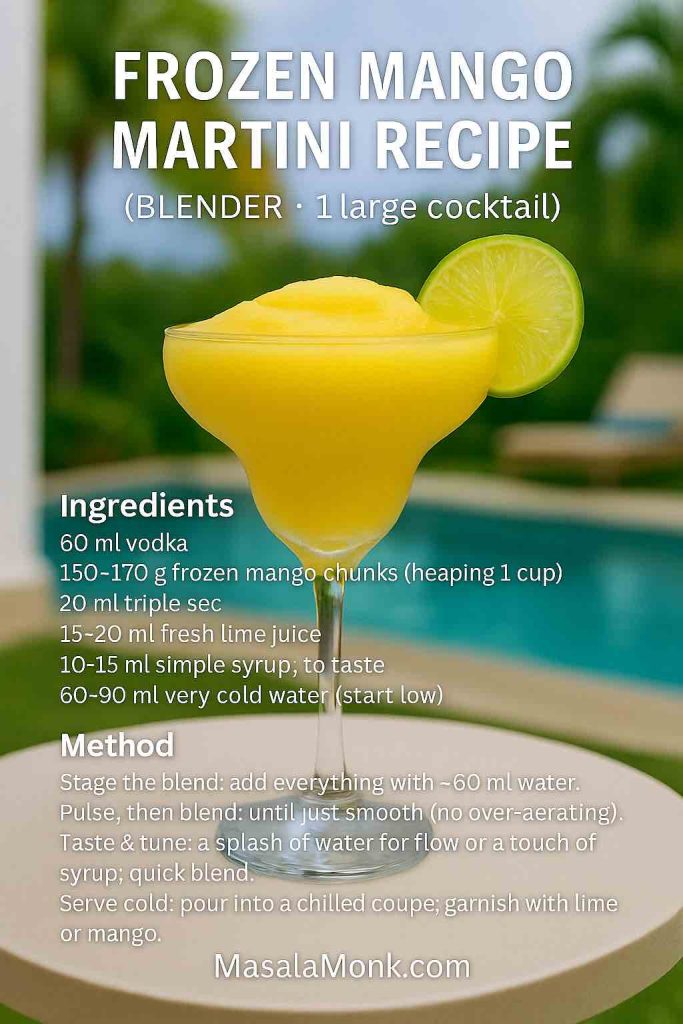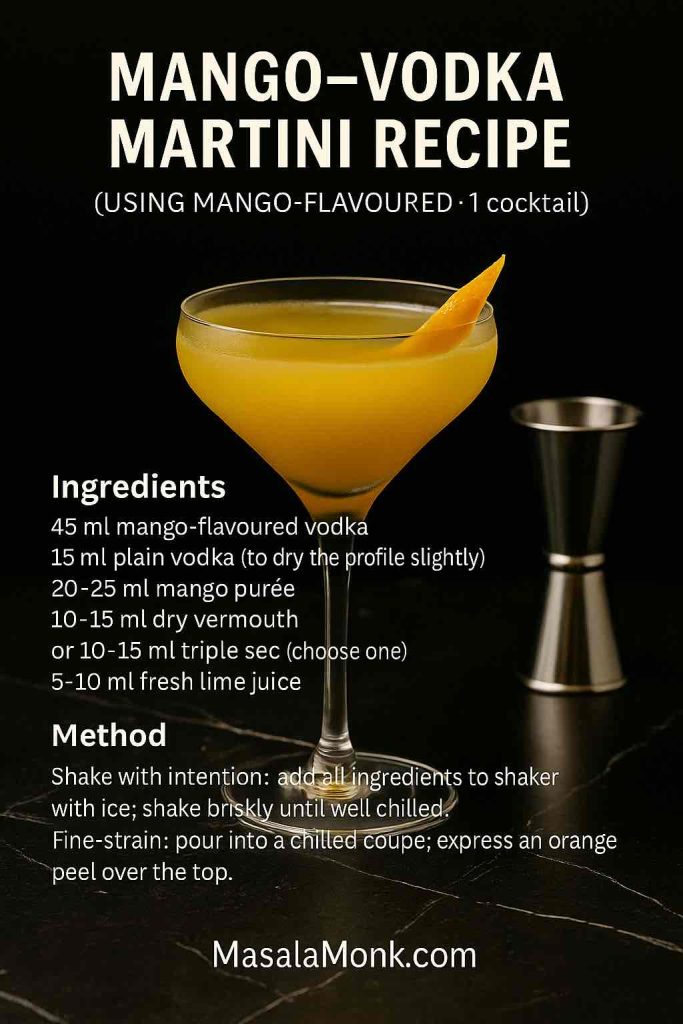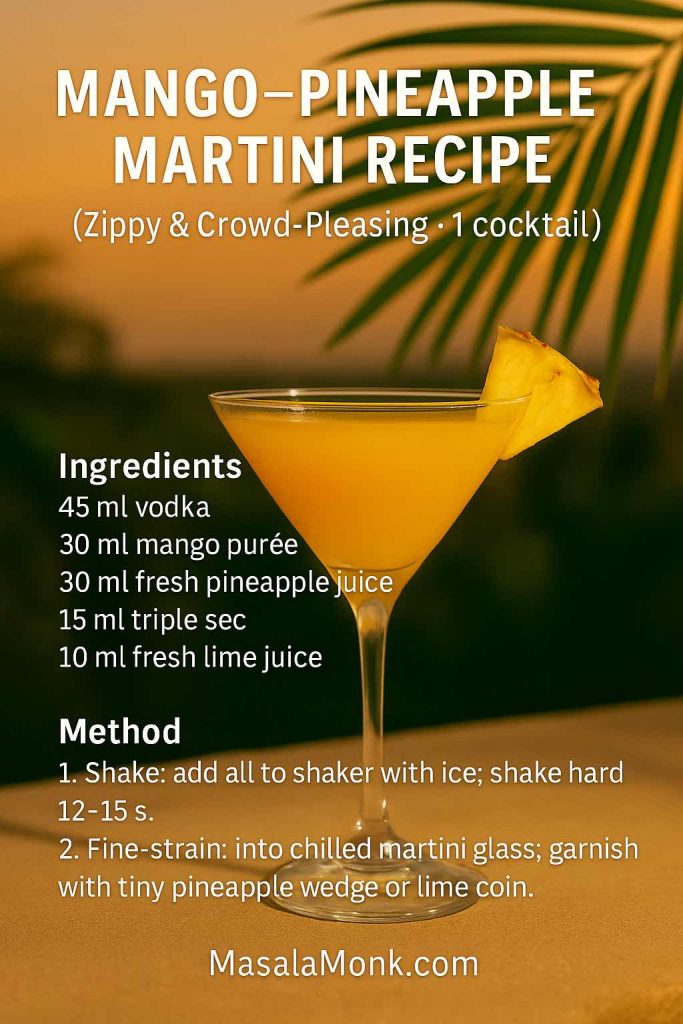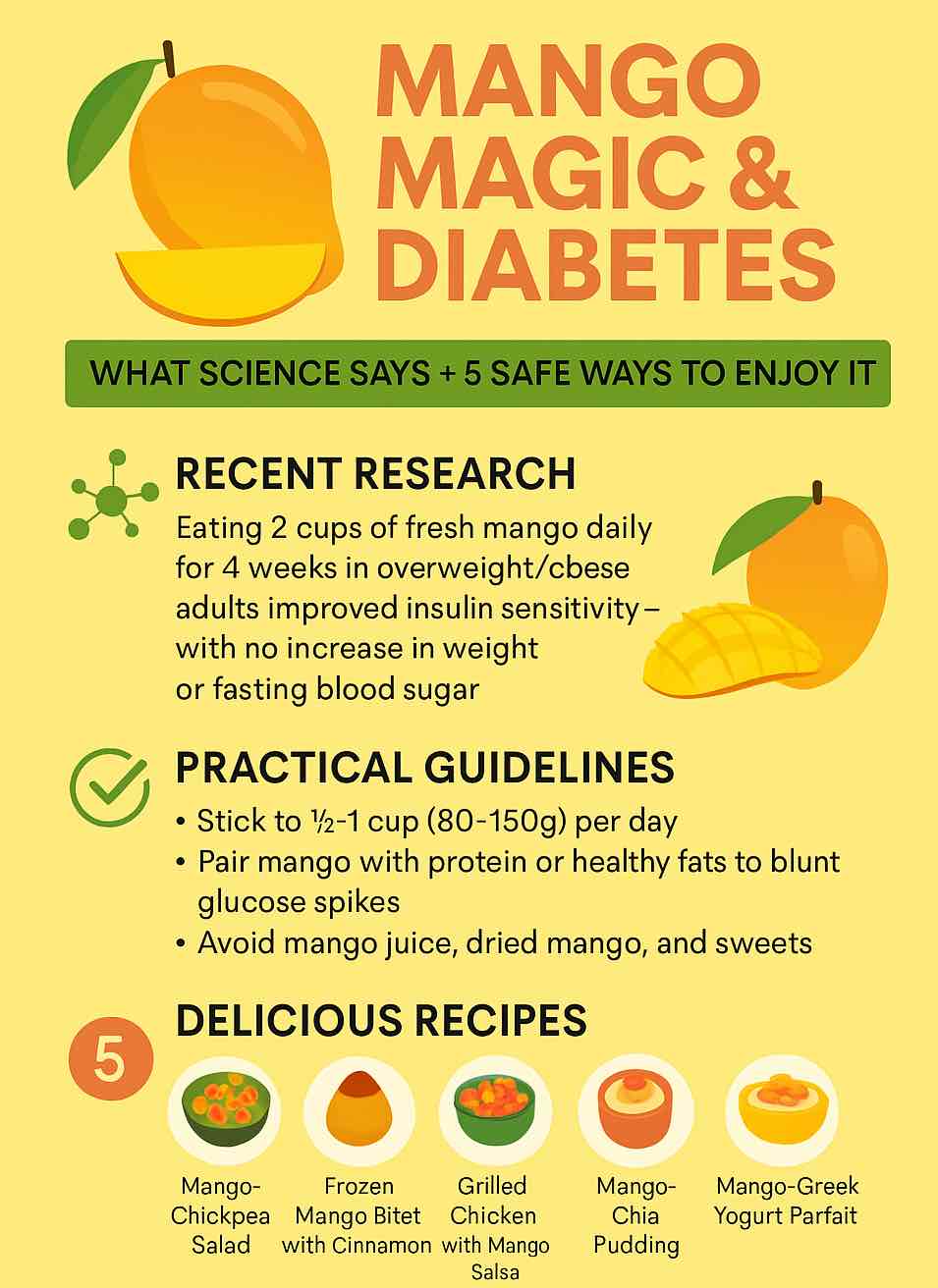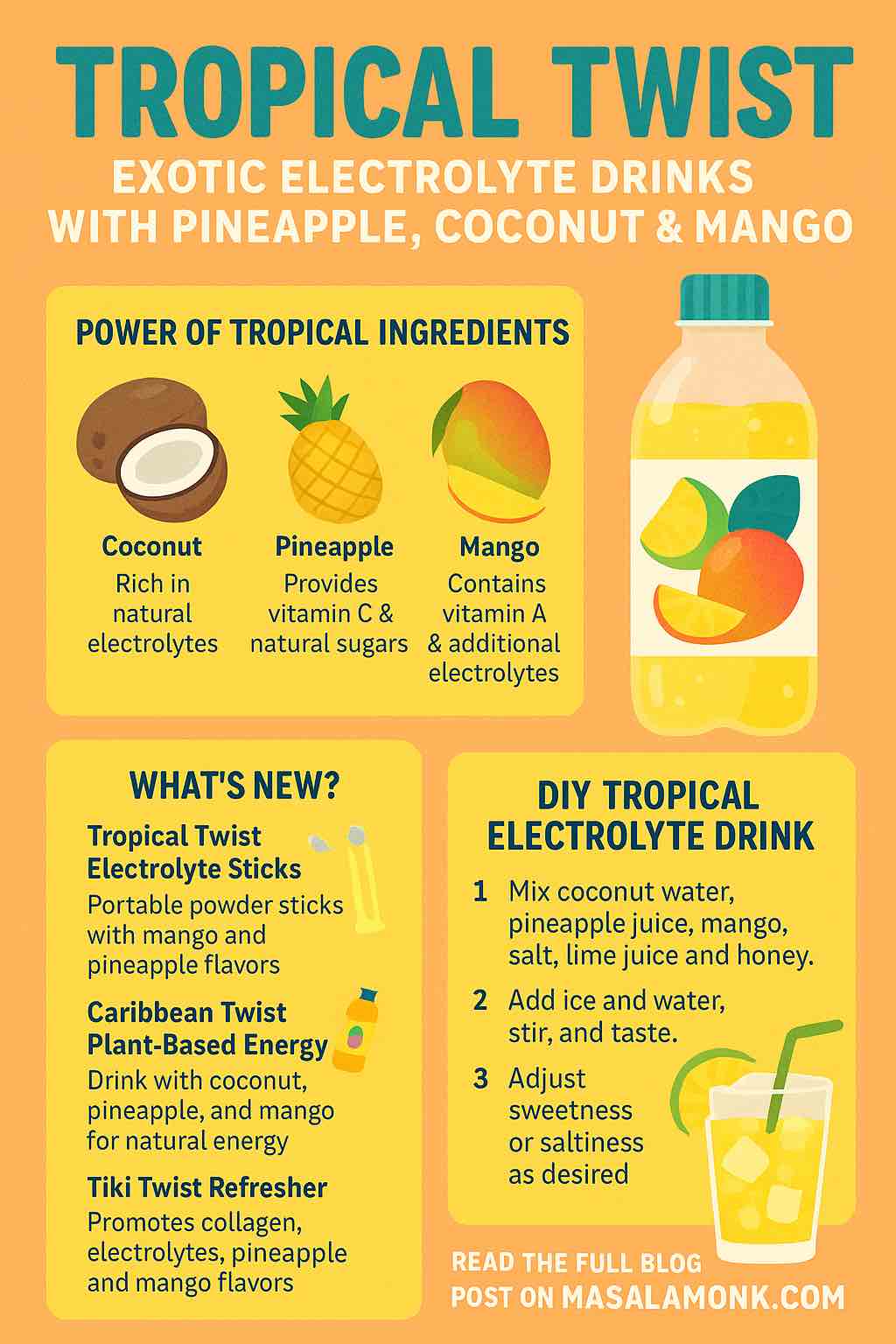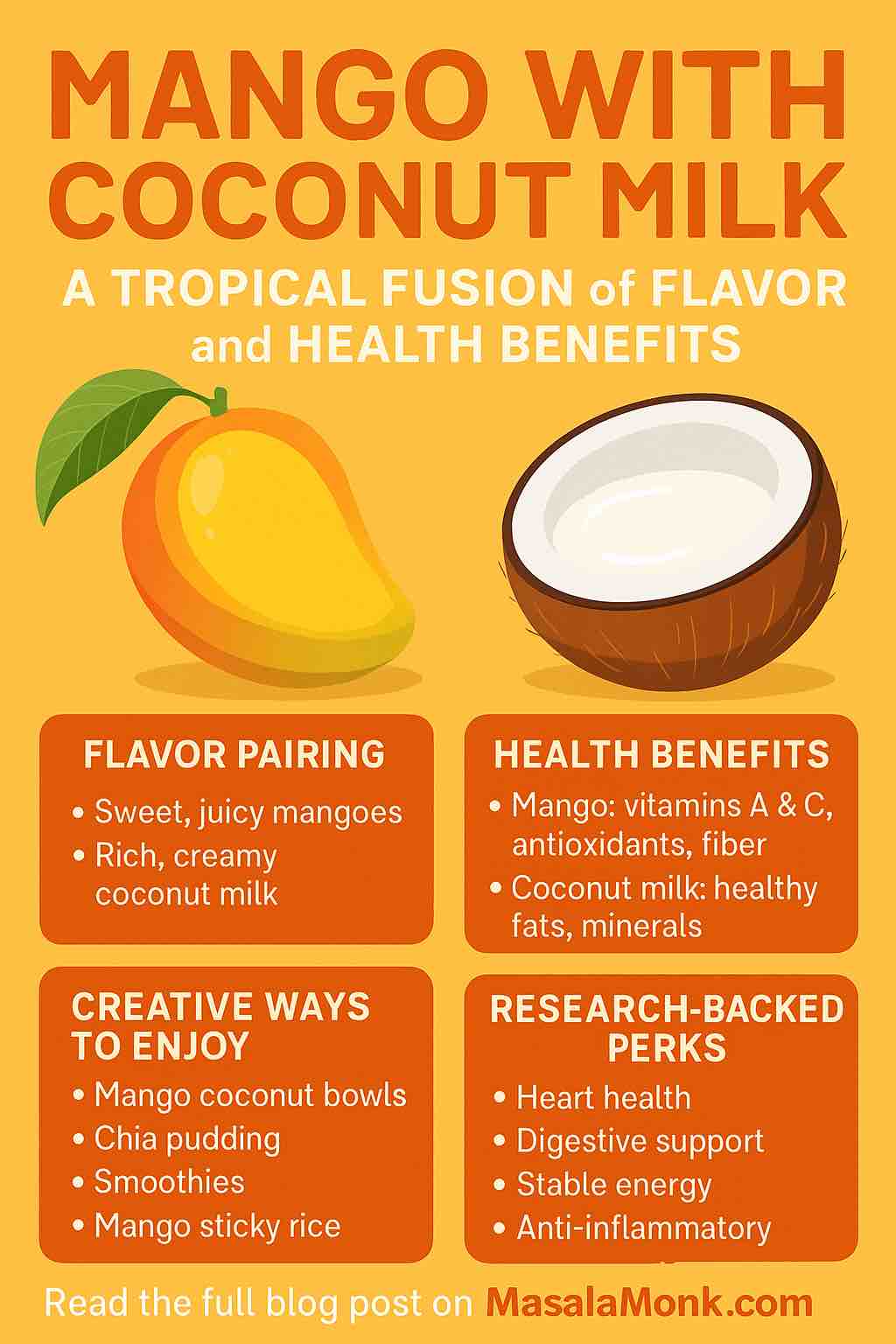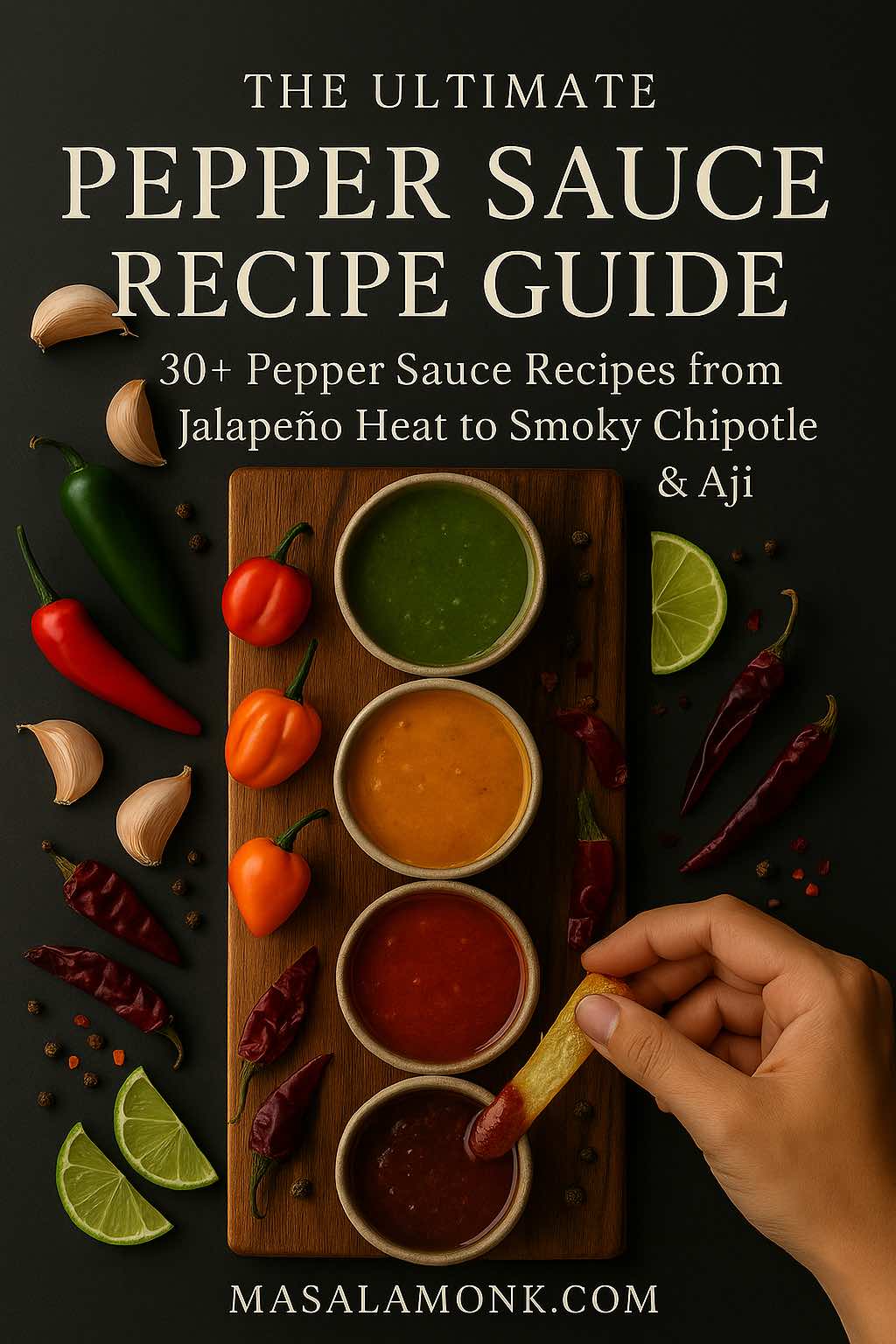
There are sauces that politely sit on the side of the plate, and then there are sauces that run the whole show. A good pepper sauce recipe belongs to that second group. A spoonful can rescue a flat stir-fry, wake up yesterday’s leftovers, or turn plain grilled vegetables into something you make on purpose.
Because “pepper sauce” is such a broad phrase, it can mean anything from a thin Louisiana-style hot pepper sauce recipe to smoky chipotle peppers in adobo sauce, fruity mango and habanero sauce, bright Peruvian aji amarillo sauce, or even a silky green peppercorn sauce for steak. This guide walks through the main families of pepper sauce, shows you how they’re related, and gives you practical recipes and variations you can actually cook in a home kitchen.
Along the way, you’ll meet jalapeno pepper sauce, habanero chili sauce, guajillo sauce, romesco sauce, ajvar, Szechuan chili oil, creamy peppercorn sauce, lemon pepper sauce, and a lot more. You’ll also see how to bend one base pepper sauce recipe into several versions: jalapeno salsa, jalapeno mayo, pineapple habanero salsa, ancho chipotle sauce, roasted red pepper pasta sauce, and even ghost pepper ranch.
Whenever the heat gets intense and you feel like balancing it with something cooling and creamy, it’s worth having a look at high-protein yogurt-based sauces like a good tzatziki with multiple variations or other dairy-based favorites such as creamy Alfredo and béchamel for lasagna. These sit on the other side of the sauce spectrum and pair beautifully with punchy pepper sauces.
Before we dive into specific recipes, let’s quickly look at the building blocks that almost every pepper sauce has in common.
What Makes a Great Pepper Sauce Recipe?
Although the flavor profiles are wildly different, most hot pepper sauce recipes are built from the same elements:
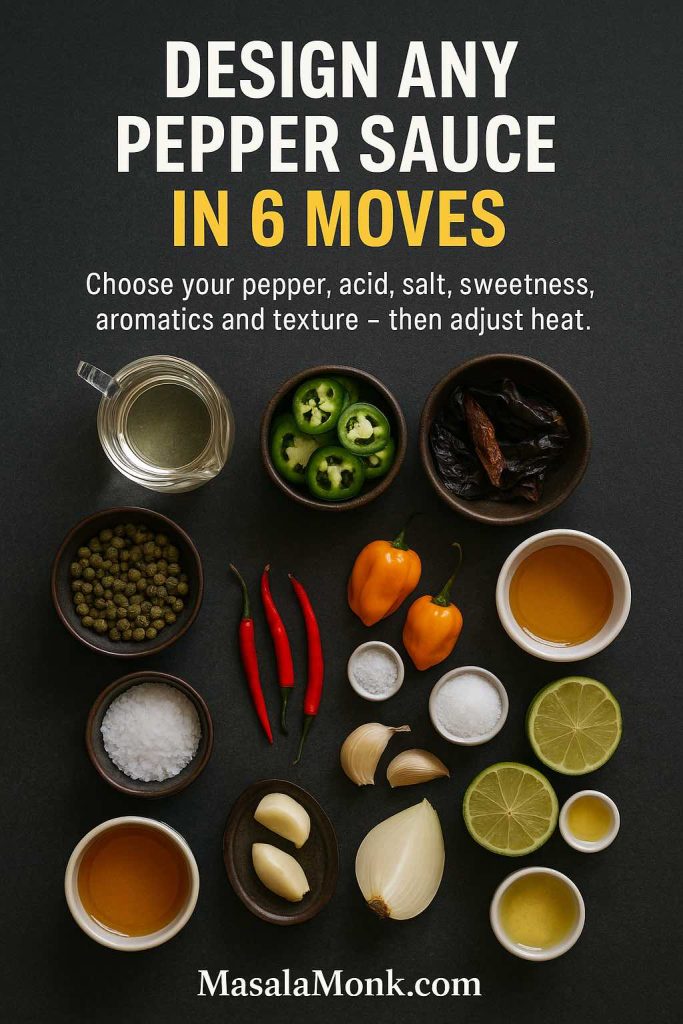
Pepper
To start, everything begins with the pepper itself. You might reach for fresh chilies (jalapeño, habanero, scotch bonnet, serrano, datil), dried chilies (guajillo, ancho, aji panca, chipotle, arbol), or peppercorns (black or green). Each choice shifts both heat and personality—ranging from smoky or earthy to grassy, fruity, citrusy, or even floral.
Acid
Next, you need something sharp to brighten the sauce. This usually comes from vinegar or citrus (lime, lemon, orange), and occasionally from a gentle fermented tang. For instance, Louisiana-style hot sauces lean hard into vinegar, whereas Peruvian aji sauces often pair lime with dairy for a rounder, creamier acidity.
Salt
From there, salt steps in as more than just seasoning. It sharpens flavor, but in fermented hot sauces it also controls preservation and microbial balance. Because of that, getting the salt percentage right is essential for both safety and proper flavor development. If fermentation is the goal, it’s wise to consult a focused fermented hot sauce guide that covers brine strength and safe procedures in detail.
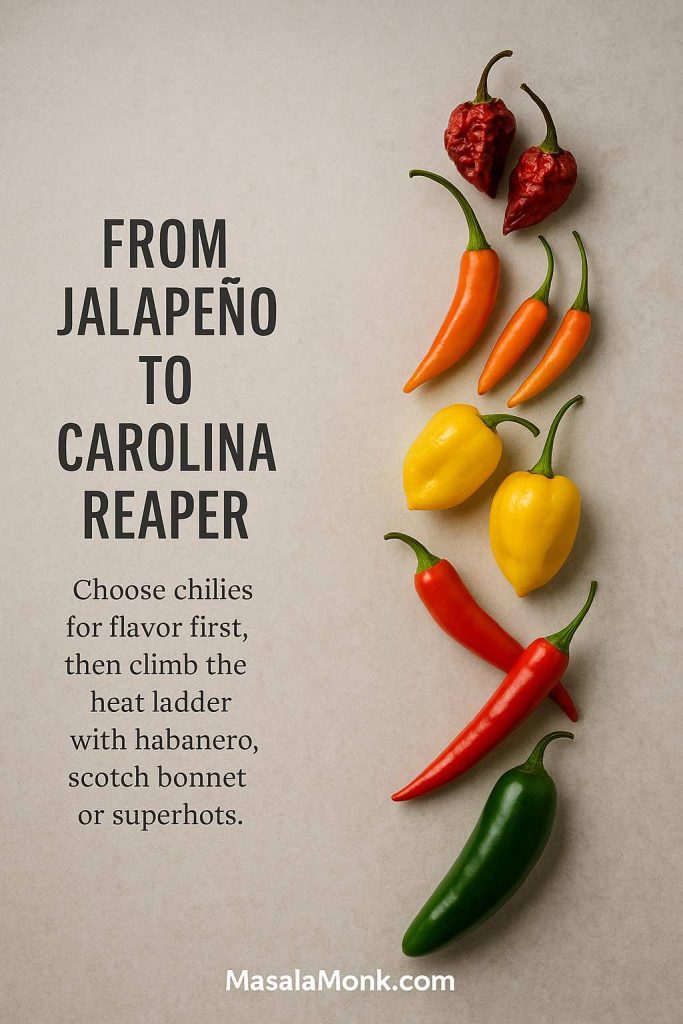
Sweetness (optional)
After you’ve set the heat and acid, a touch of sweetness can smooth the edges. Sugar, jaggery, honey, or fruits like mango, pineapple, peach, or even blueberry can soften aggressive heat. They’re the reason mango habanero wing sauce, pineapple habanero jelly, and habanero peach BBQ sauce end up craveable instead of just punishing.
Aromatics
Once the core flavors are in place, aromatics bring depth. Garlic, onion, herbs, and spices (such as cumin, oregano, or paprika) create complexity, while additions like nuts—as in romesco or ajvar—lend richness and a subtle, toasty backbone.
Texture
Finally, the way the sauce feels matters as much as how it tastes. It can be thin and pourable (like Louisiana hot sauce or cayenne pepper sauce), chunky (as in jalapeño relish or pineapple habanero salsa), thick and spreadable (ajvar or sweet pepper paste), or lush and creamy (habanero cream sauce, jalapeño ranch, peppercorn gravy). The chosen texture should match how you plan to use the sauce—whether splashed, spooned, spread, or drizzled.
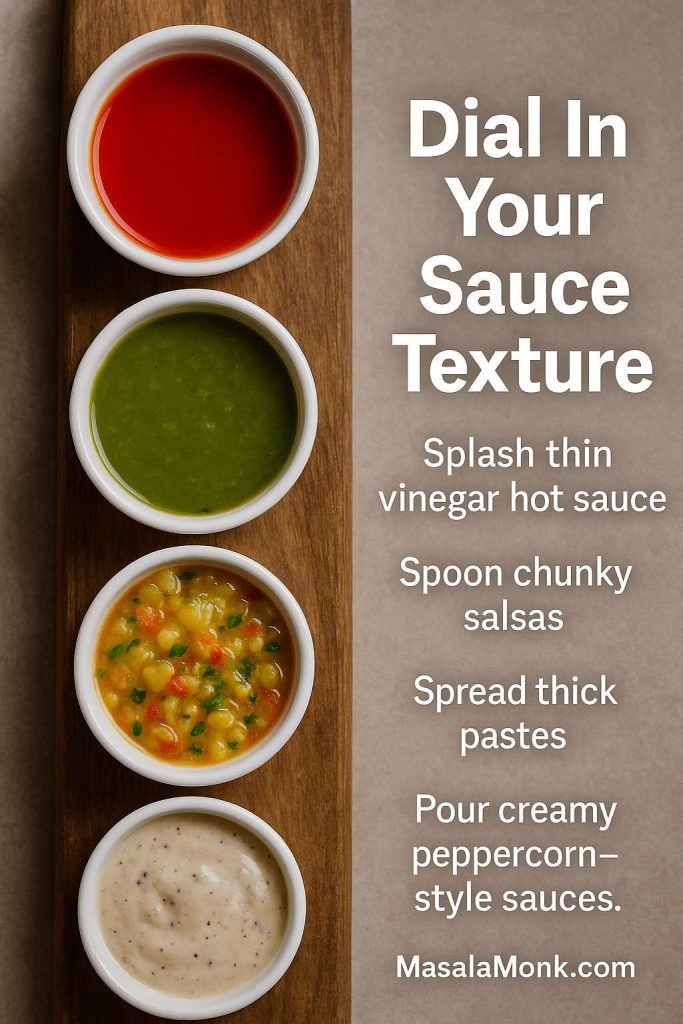
Once you see these levers, it becomes much easier to understand how different pepper sauce recipe versions relate to one another. So let’s start with the most familiar: classic vinegar-based hot pepper sauce.
Also Read: Healthy Tuna Salad – 10 Easy Recipes (Avocado, Mediterranean, No Mayo & More)
Classic Vinegar Hot Pepper Sauce
Thin, sharp, vinegary and bright red: this style of pepper sauce recipe is what many people associate with the word “hot sauce”. It covers Louisiana hot sauce, simple cayenne hot pepper sauce, Southern hot pepper vinegar, and a whole family of Caribbean hot sauces built around habanero and scotch bonnet chili.
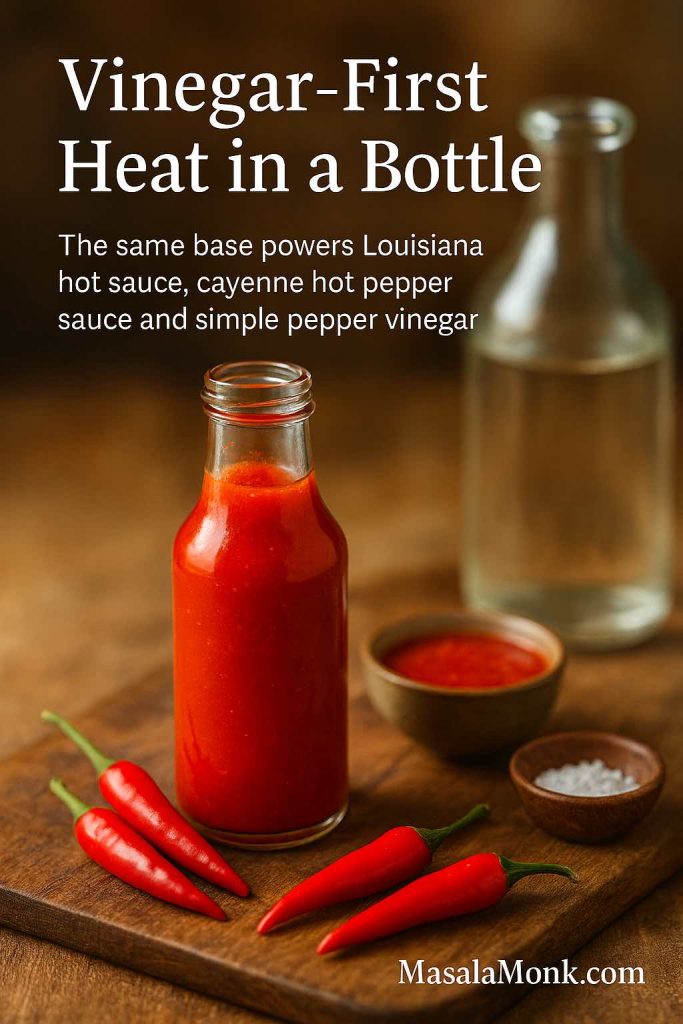
Simple Louisiana-Style Hot Pepper Sauce Recipe
This recipe gives you a classic hot pepper sauce that works with cayenne or any thin-skinned hot chili. It rivals bottled favorites like Tabasco-style chili sauce and Frank’s-style cayenne red pepper sauce, yet it’s easy enough for a beginner.
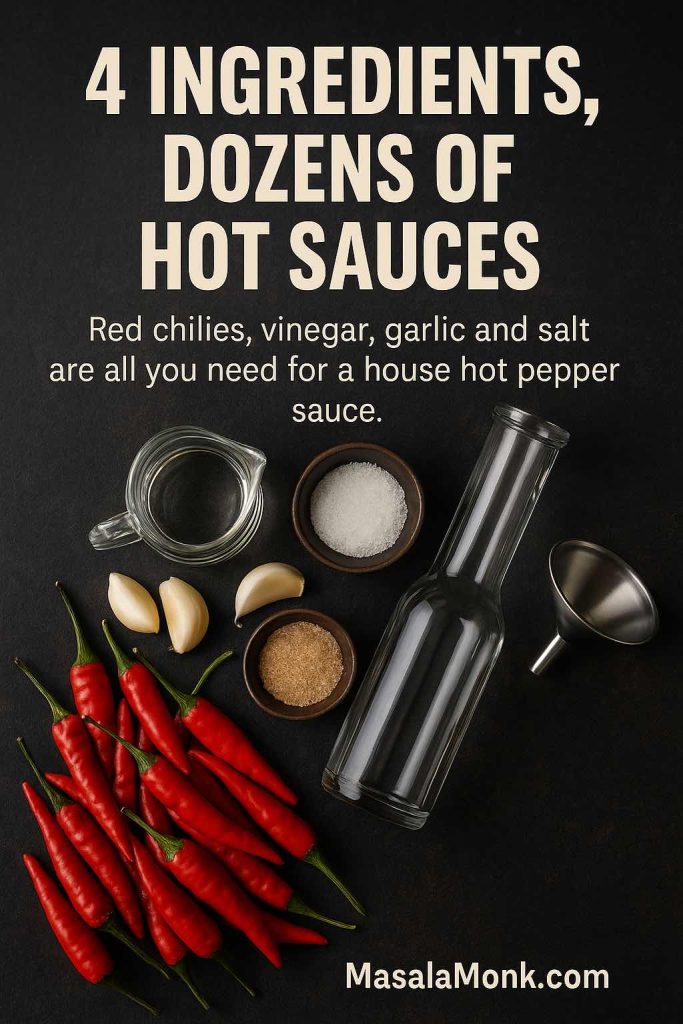
Ingredients
- 300 g fresh red chilies (cayenne, tabasco-type or mixed hot peppers)
- 250 ml white vinegar (you can swap part for apple cider vinegar)
- 3 cloves garlic
- 1 tsp salt
- ½ tsp sugar (optional, but balances the tang)
Method or Recipe
- Rinse the chilies, trim the stems and, if you want a slightly milder hot pepper sauce, slit them to remove some seeds.
- Combine chilies, garlic, vinegar, salt and sugar in a saucepan. Simmer gently for 8–10 minutes, just until softened.
- Cool for a few minutes, then blend everything until very smooth.
- If you prefer a very silky Louisiana-style pepper sauce, strain through a fine sieve; otherwise keep the pulp.
- Bottle while still slightly warm in a clean glass bottle or jar. Let your pepper sauce rest in the fridge for at least a day before using; it improves dramatically after a week.
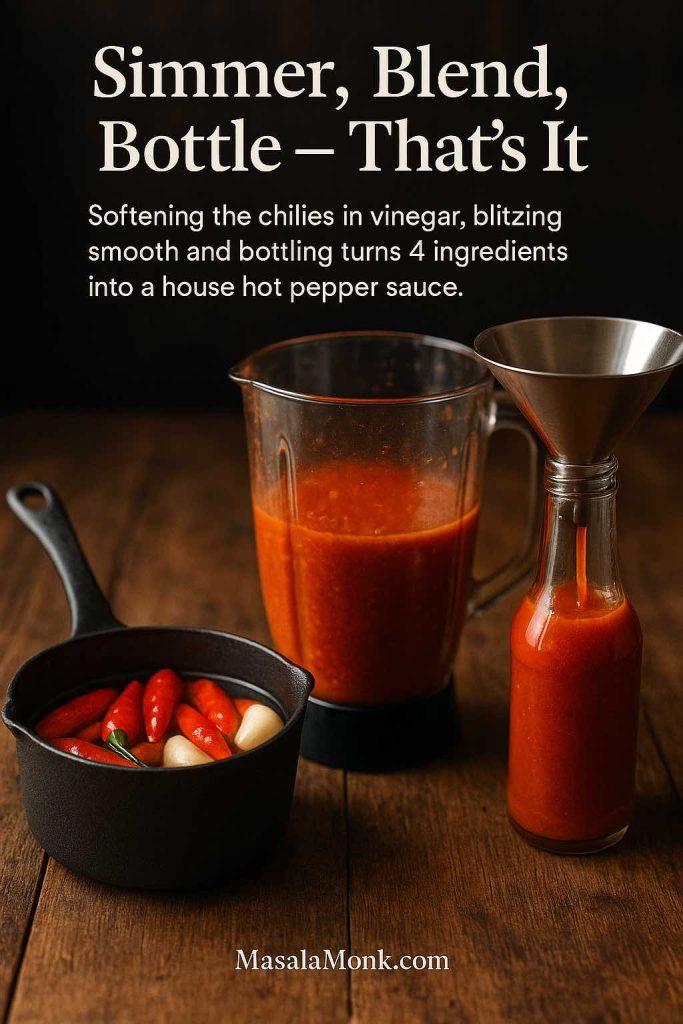
You’ve now got a base that can play many roles. With a few tweaks it becomes:
- Cayenne hot pepper sauce: use only cayenne and keep it unstrained.
- Southern pepper vinegar sauce: pour hot vinegar and salt over whole slit chilies in a bottle and let it steep instead of blending – that’s the classic pepper vinegar for greens and beans.
- Scotch bonnet hot sauce or Jamaican hot pepper sauce: replace some or all of the chilies with scotch bonnet chili or habanero, add carrot and onion, and blend less vinegar for a thicker Caribbean hot pepper sauce.
If you love a bit of science in your kitchen, you can also move into fermented hot sauce territory by packing chopped chilies and garlic in salted brine, letting them ferment for a week or two, then blending with vinegar. For precise salinity and safety tips, it’s worth cross-checking against a detailed fermented hot sauce tutorial.
Also Read: Potato Salad Recipe: Classic, Russian, German, Vegan & More
Recipe for Jalapeno Pepper Sauce, Salsas, Mayo and Relish
Next, it helps to shift to something greener and friendlier. Jalapeno pepper sauce is a perfect “gateway” hot sauce: moderate heat, bright flavor, and endless variations like jalapeno salsa, jalapeno cream sauce, jalapeno mayo and even jalapeno pepper jam.
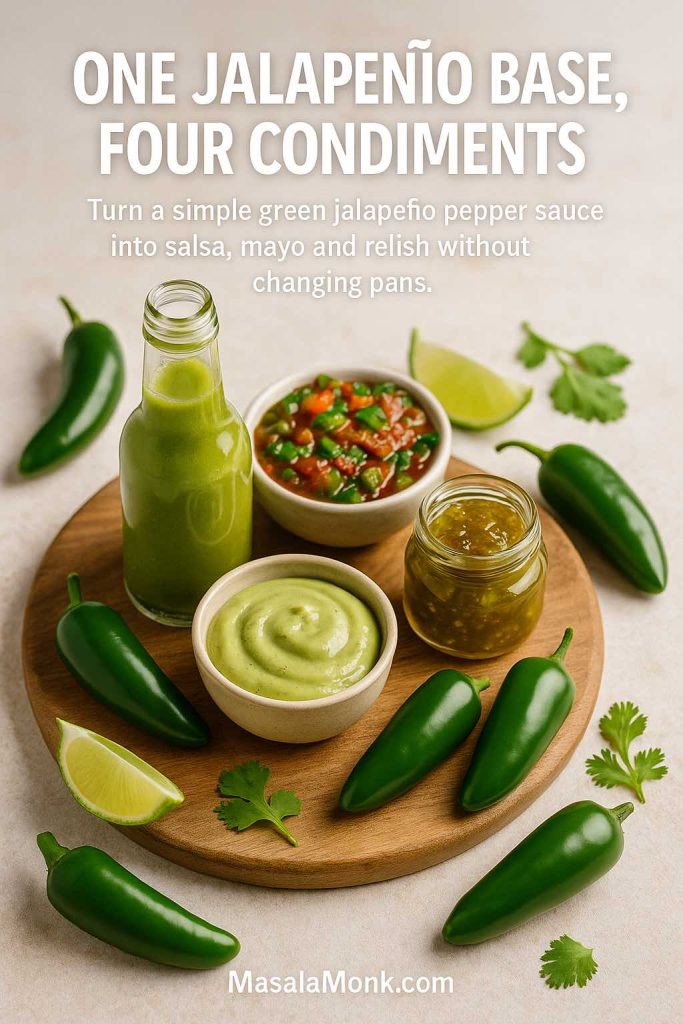
Fresh Green Jalapeno Pepper Sauce Recipe
This jalapeno hot sauce recipe gives you a grassy, tangy green chili sauce that works on tacos, eggs, burgers and grain bowls.

Ingredients
- 10–12 fresh jalapeños
- ½ small onion
- 3 cloves garlic
- 120 ml white vinegar
- Juice of 1 lime
- 1 tsp salt
- Small handful coriander (optional)
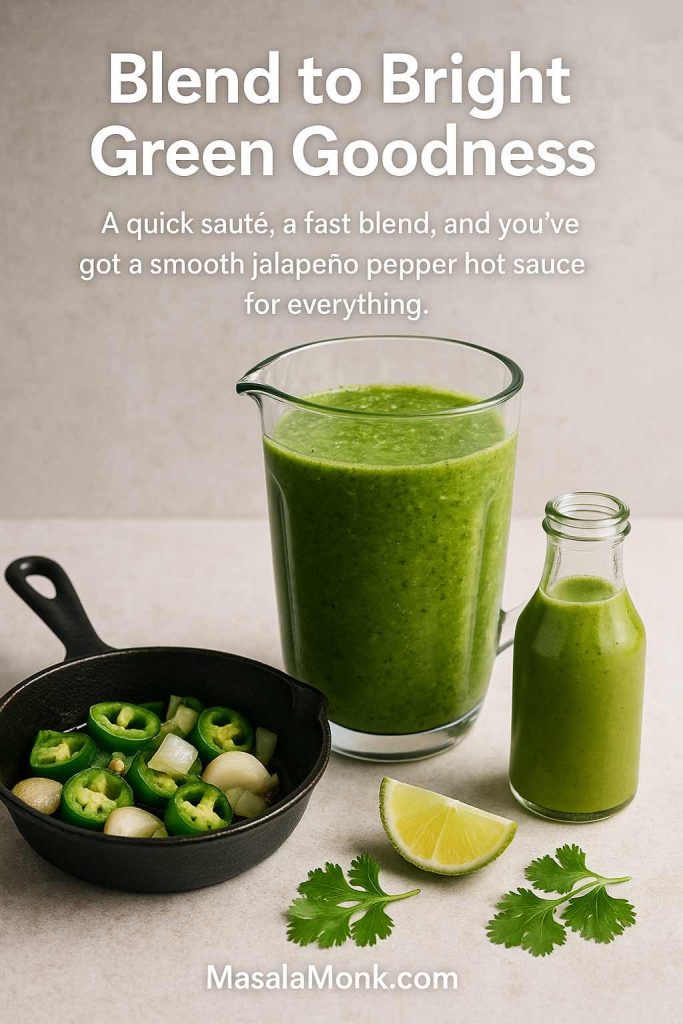
Method
- Slice jalapeños and onion; peel the garlic. If you want a very mild pepper sauce, remove the seeds from some of the jalapeños.
- Add jalapeños, onion and garlic to a small pan with a splash of water. Cover and simmer 5–6 minutes, just to soften.
- Tip everything into a blender, add vinegar, lime juice, coriander and salt, then blend until perfectly smooth.
- Taste and adjust. More vinegar makes it sharper; a pinch of sugar softens the edges. If it’s too thick, thin with a little water.
- Bottle and refrigerate. The color may mellow over time but the flavor deepens.
Within a few minutes, you’ve created a green jalapeno pepper hot sauce that sits somewhere between salsa verde and a pourable chili pepper sauce.
Smoked Jalapeno and Lime Hot Sauce
If you enjoy deeper flavor, you can double down on the smokiness:
- Replace some jalapeños with smoked jalapeno (chipotle) or stir in a spoonful of chipotle chili in adobo sauce at blending time.
- Boost the lime juice for a bright jalapeno lime hot sauce that tastes fantastic on grilled fish or paneer tikka.
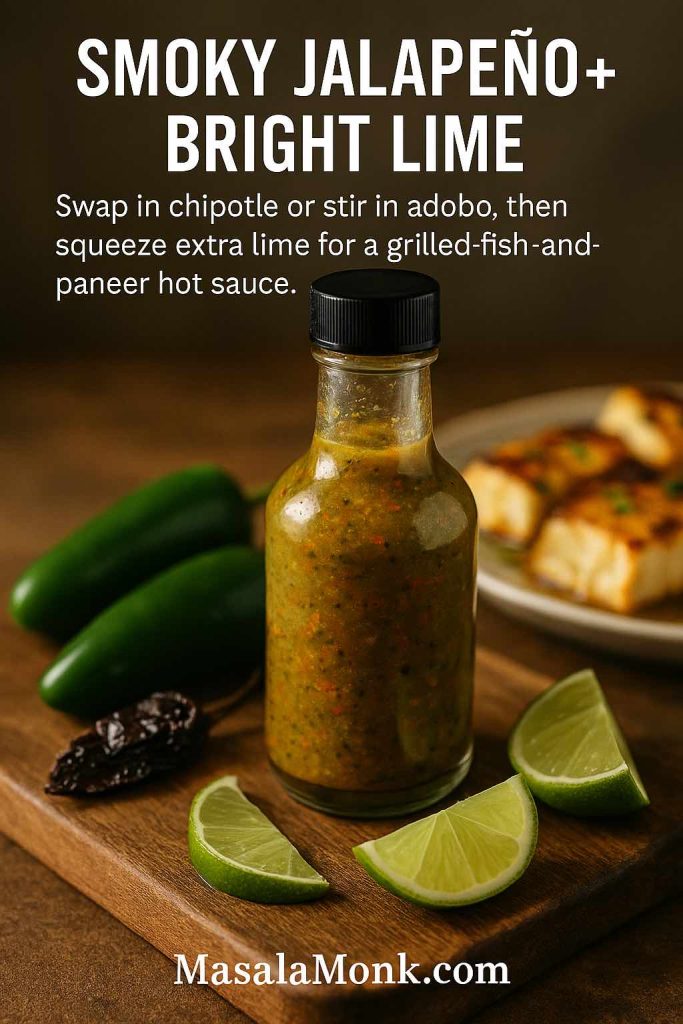
This is a great place to mention chipotle early, because it links this jalapeno family to the chipotle and adobo section later.
Jalapeno Mayo, Ranch and Cream Sauce
Once you have a basic jalapeno sauce, it becomes surprisingly easy to turn it into creamy jalapeno sauce variations:
- Stir a spoon or two into mayonnaise, yogurt or sour cream for jalapeno mayo, jalapeno aioli or jalapeno ranch dipping sauce.
- Add chopped coriander, lime and garlic for extra lift.
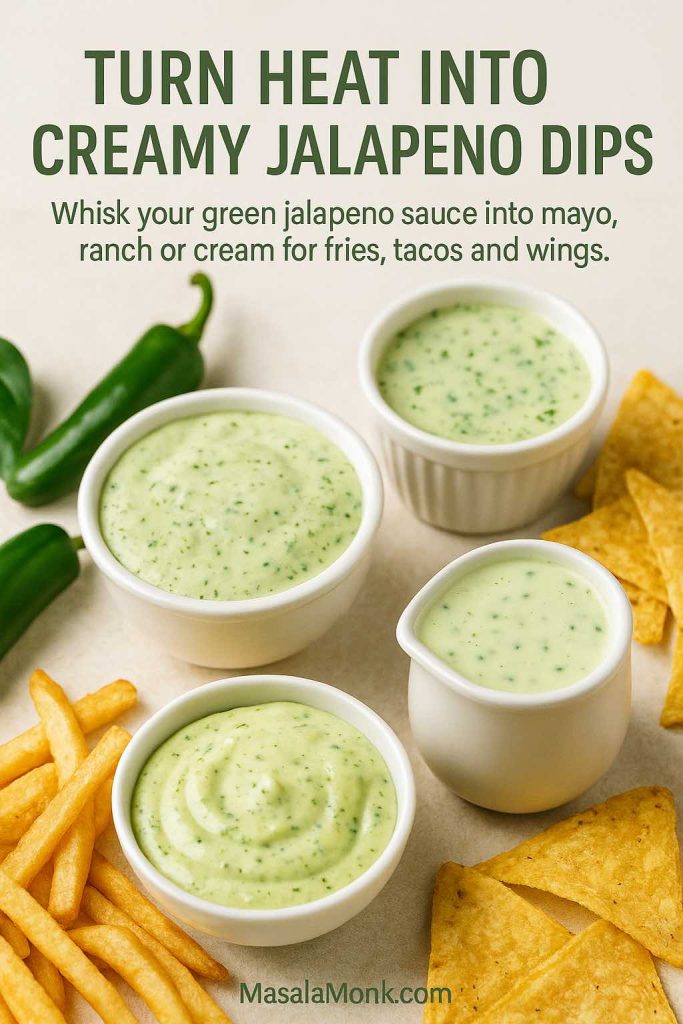
A creamy jalapeno ranch sits nicely beside rich foods like fried chicken, wedges or nachos, just as yogurt-based dips like tzatziki balance grilled meats and vegetables.
Jalapeno Relish and Hot Pepper Jelly
Not every jalapeno sauce has to be smooth. Relishes and jellies give you texture and concentrated flavor:
- Jalapeno relish or candied jalapeno relish uses chopped jalapeno, vinegar, sugar and spices simmered until sticky.
- A jalapeno pepper jam recipe often combines jalapeno with fruit like pineapple, raspberry or apple and sets it with pectin to create a glossy hot pepper jelly.
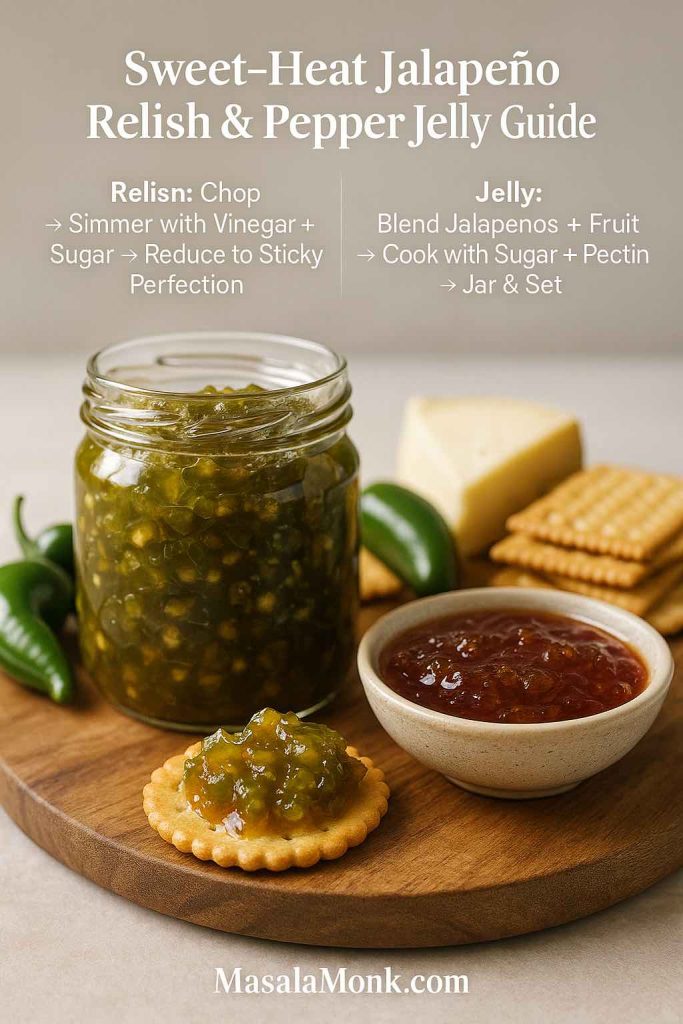
These are magic on cheese boards, sandwiches and burgers, especially when served alongside other tangy, fruity spreads like cranberry sauce with orange juice variations.
Habanero Sauce, Scotch Bonnet Hot Sauce and Fruity Variants
As you step up from jalapeno toward habanero and scotch bonnet chili, the heat increases dramatically; however, so does the fruitiness. Habanero hot sauce, scotch bonnet hot sauce and Caribbean hot pepper sauce all share this bright, tropical character.
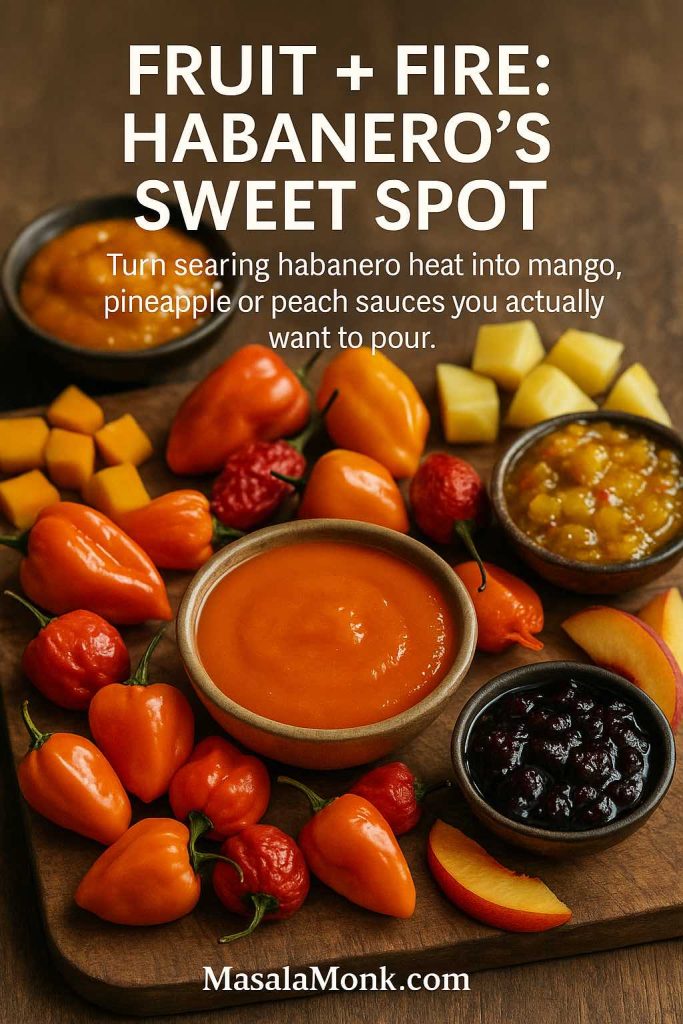
Basic Habanero Hot Pepper Sauce
This habanero pepper sauce uses carrot to round out the heat and make a more balanced hot pepper sauce recipe.
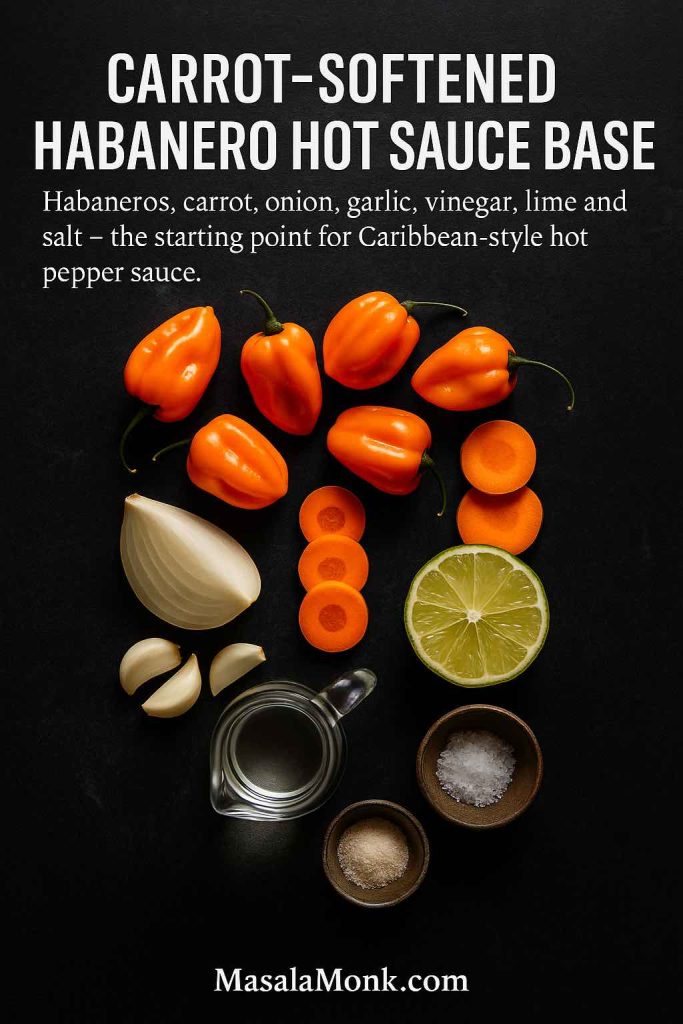
Ingredients
- 8–10 orange habanero chilies
- 1 carrot, sliced
- ½ onion, chopped
- 3 cloves garlic
- 250 ml white vinegar
- Juice of 1 lime
- 1–1½ tsp salt
Method
- In a saucepan, combine carrot, onion, garlic, habaneros and vinegar. Simmer until the vegetables are tender and the habanero flesh has softened.
- Cool slightly, then blend until very smooth, adding lime juice and a splash of water if needed.
- Taste for salt and acidity. Adjust until it feels punchy but not harsh.
- Bottle and refrigerate. After a couple of days, the flavors meld into a rounded habanero chili sauce.

By swapping habanero for scotch bonnet chili, you immediately slide into scotch bonnet hot sauce territory, a style widely used in Jamaican hot pepper sauce and other Caribbean hot sauces.
Mango and Habanero Sauce
Because habanero has such a fragrant, fruity note, it pairs naturally with mango. That’s why mango habanero wing sauce turns up on so many menus. You can build your own mango and habanero sauce from the classic base:
- Blend 1 cup ripe mango chunks into the hot sauce.
- Add 1–2 tablespoons honey or brown sugar if you want a stickier glaze.
- Simmer briefly after blending to tighten the texture.
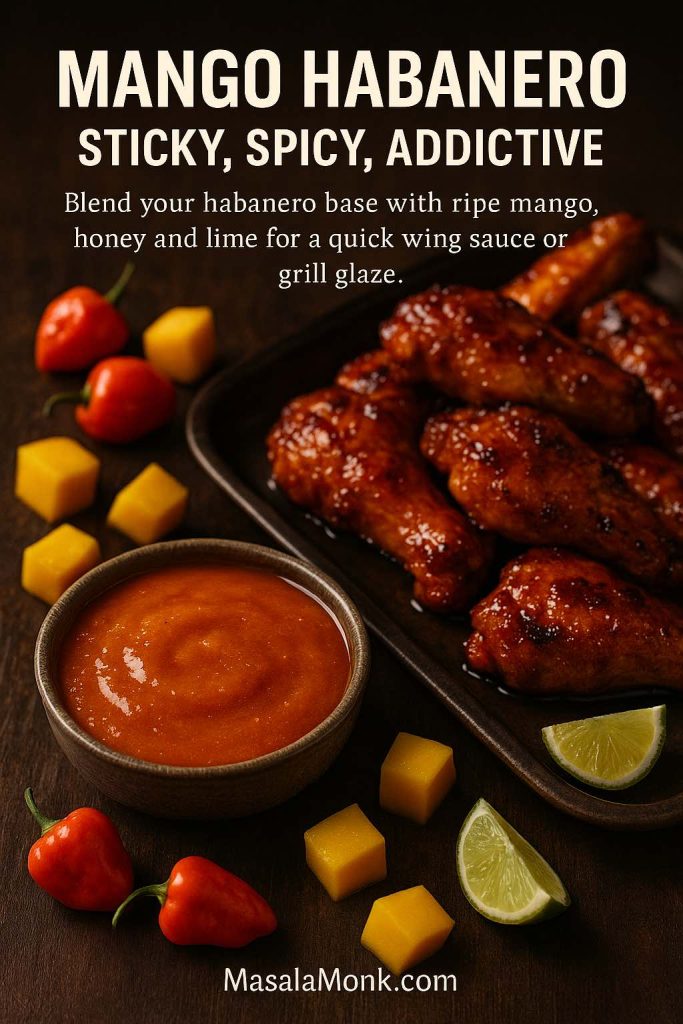
Brushed onto grilled chicken, cauliflower or wings, this mango habanero hot sauce gives you sticky, spicy, sweet flavors in one quick move. If you prefer less sweetness and more zing, lemon pepper sauce or hot lemon pepper sauce made with butter, lemon zest and cracked pepper is a great contrast to sticky mango habanero wing sauce.
Pineapple Habanero, Peach Habanero and More
The same pattern works with other fruits:
- Pineapple and habanero sauce or pineapple habanero salsa (with red onion and coriander) is brilliant with tacos, grilled seafood, or paneer skewers.
- Peach habanero salsa is ideal for pork chops or roast chicken.
- Blueberry habanero hot sauce, darker and almost chutney-like, does wonders on cheeseboards or with rich sausages.
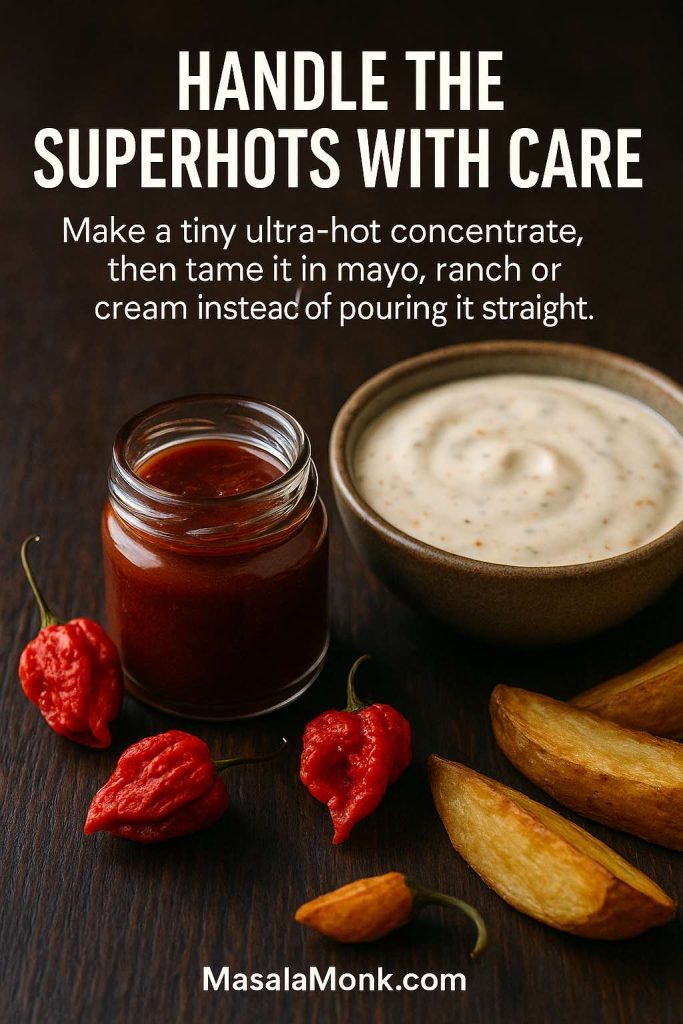
If you’re tempted by phrases like “world hottest sauce”, it’s worth remembering how concentrated superhot peppers are. Carolina Reaper, Trinidad scorpion pepper and ghost chili hot sauce are best treated like seasonings rather than regular condiments – a small spoonful of superhot pepper mash stirred into mayo, yogurt or ranch makes a safer ghost pepper ranch or habanero trinidad scorpion pepper sauce than pouring it straight onto your food.
Also Read: Upma Recipe: 10+ Easy Variations (Rava, Millet, Oats, Semiya & More)
Chipotle Pepper in Adobo Sauce and Chipotle Hot Sauce
Chipotle peppers – essentially smoked, dried jalapenos – become incredibly versatile once they are cooked in an adobo sauce made of tomato, vinegar, sugar and spices. When chipotle goes in adobo sauce it becomes the smoky backbone of many Tex-Mex and Mexican-inspired recipes, from chipotle hot sauce to creamy chipotle mayo.
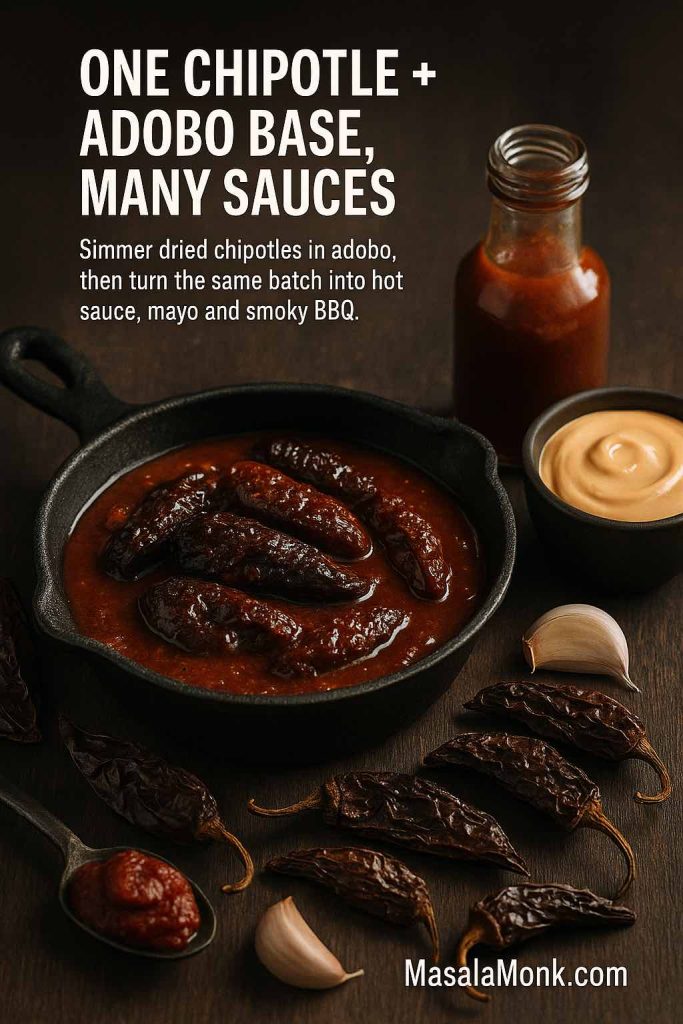
Homemade Chipotle in Adobo Sauce
Instead of always reaching for canned chipotle peppers in adobo, you can make your own. A homemade pan of chipotle peppers in adobo sauce feels deeply smoky and is surprisingly simple recipe.
Ingredients
- 8–10 dried chipotle chilies
- 1 small onion, finely chopped
- 3 cloves garlic, minced
- 2 tablespoons tomato paste
- 250 ml water or light stock
- 60 ml apple cider vinegar
- 1–2 tablespoons brown sugar
- 1 teaspoon salt
- ½ teaspoon ground cumin
- ½ teaspoon oregano
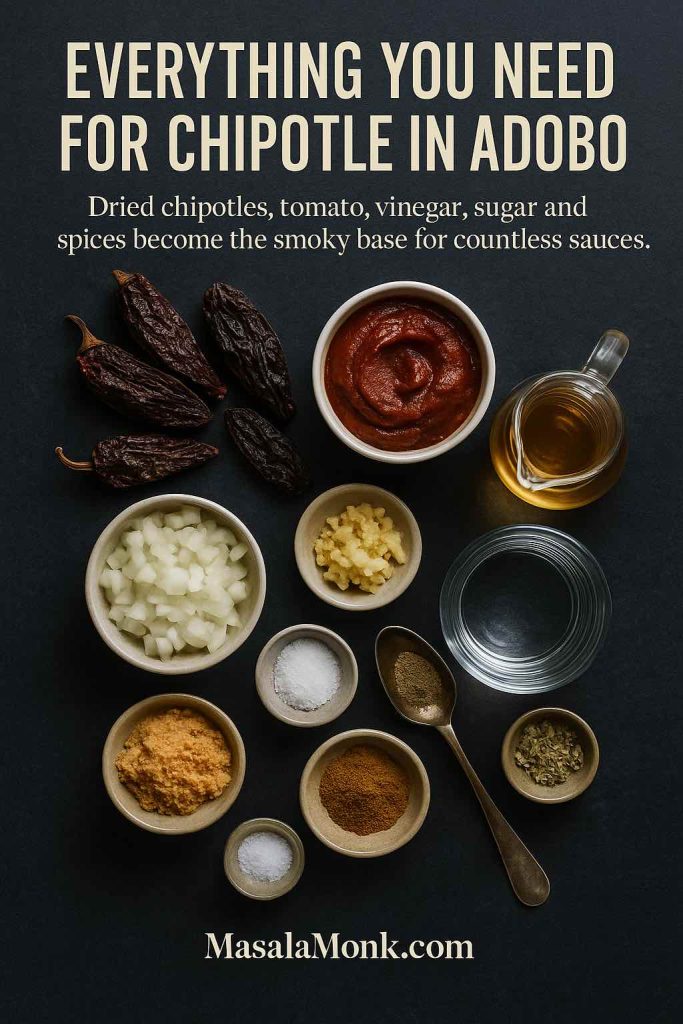
Recipe for Homemade Chipotle
- Toast the dried chipotle peppers briefly in a dry pan until fragrant, then cover with hot water and soak for 20–30 minutes.
- In a saucepan, sauté onion and garlic in a little oil until they soften. Stir in tomato paste, cumin and oregano; fry for a minute.
- Add the softened chipotles, 250 ml of the soaking liquid or stock, vinegar, sugar and salt. Simmer gently for about 20 minutes until the chilies are glossy and the adobo sauce is thick and rich.
- Adjust seasoning. Some people like more sugar for a sweeter adobo chipotle; others increase vinegar for a sharper chili pepper adobo sauce.
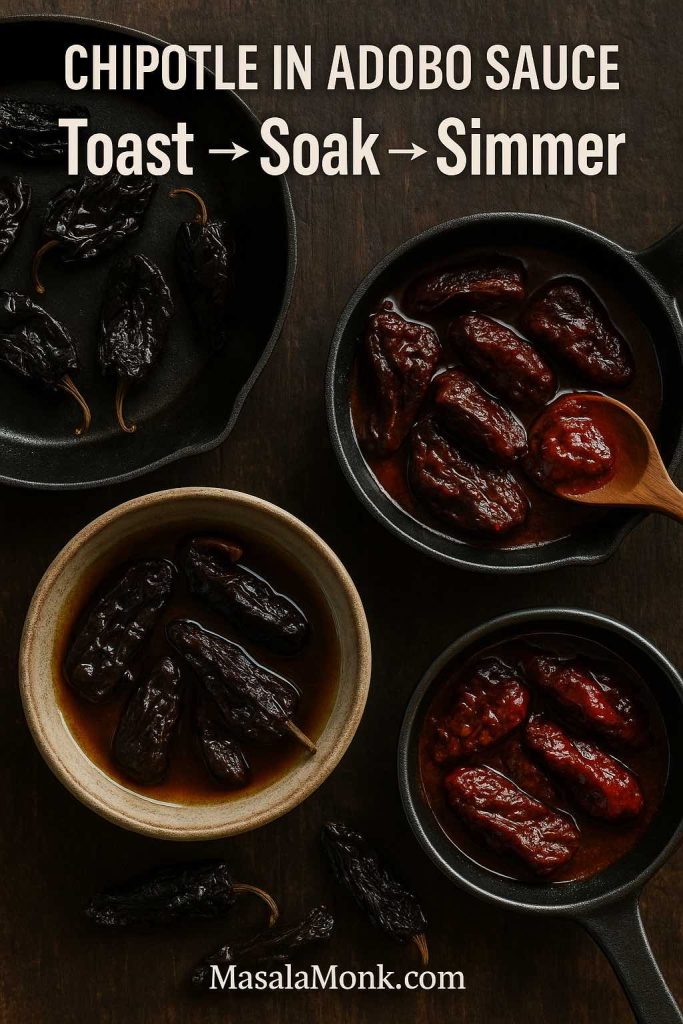
You can leave the chipotles whole, creating classic chipotle chiles en adobo, or blend part of the batch for a smoother chile chipotle sauce. The process is similar to many detailed guides such as this homemade chipotles in adobo recipe, which walks through soaking, simmering and seasoning in depth.
Quick Chipotle Hot Pepper Sauce
Once you have chipotle and adobo sauce ready, it takes almost no effort to create a smoky, pourable chipotle pepper hot sauce:
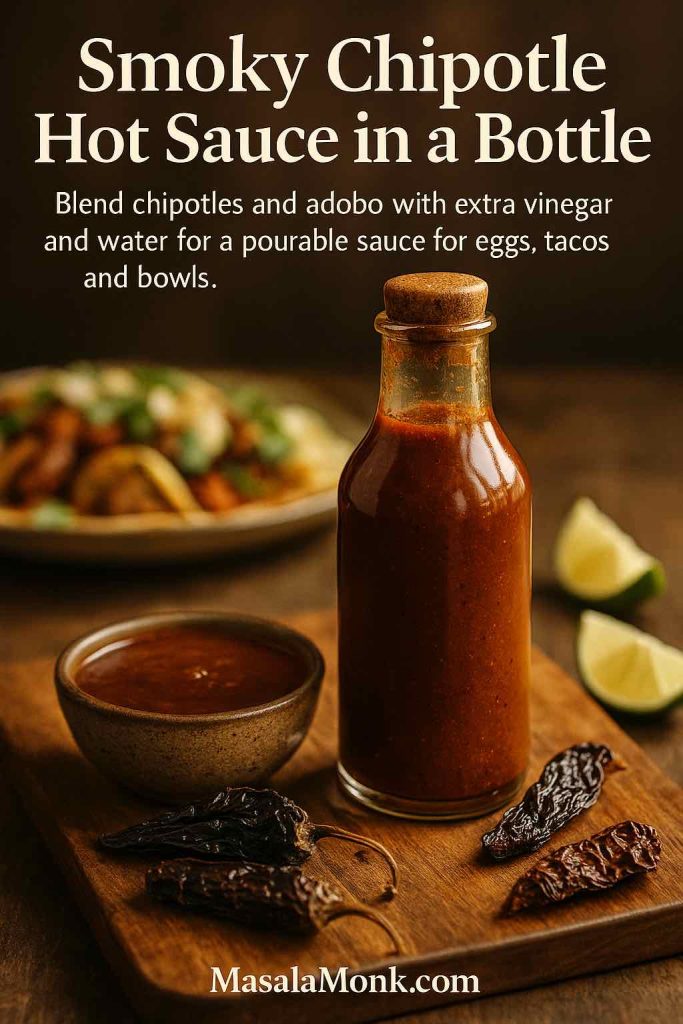
- Blend several chipotles and some adobo sauce with extra vinegar and a splash of water until you reach your preferred thickness.
- Taste and balance with more sugar, salt or vinegar.
This chipotle pepper sauce is wonderful on eggs, roasted vegetables, grilled tofu and burritos.
Chipotle Mayo, Cream Sauce and BBQ
Chipotle and adobo also form the base of many creamy sauces:
- Blend adobo sauce with mayonnaise and yogurt for a smoky chipotle mayo or chipotle sauce that works on burgers, tacos, bowls and sandwiches.
- Fold chipotle in adobo into a simple mix of ketchup, vinegar, brown sugar and spices to make chipotle BBQ sauce or even a spicy Dr Pepper barbecue sauce if you add a splash of soda.
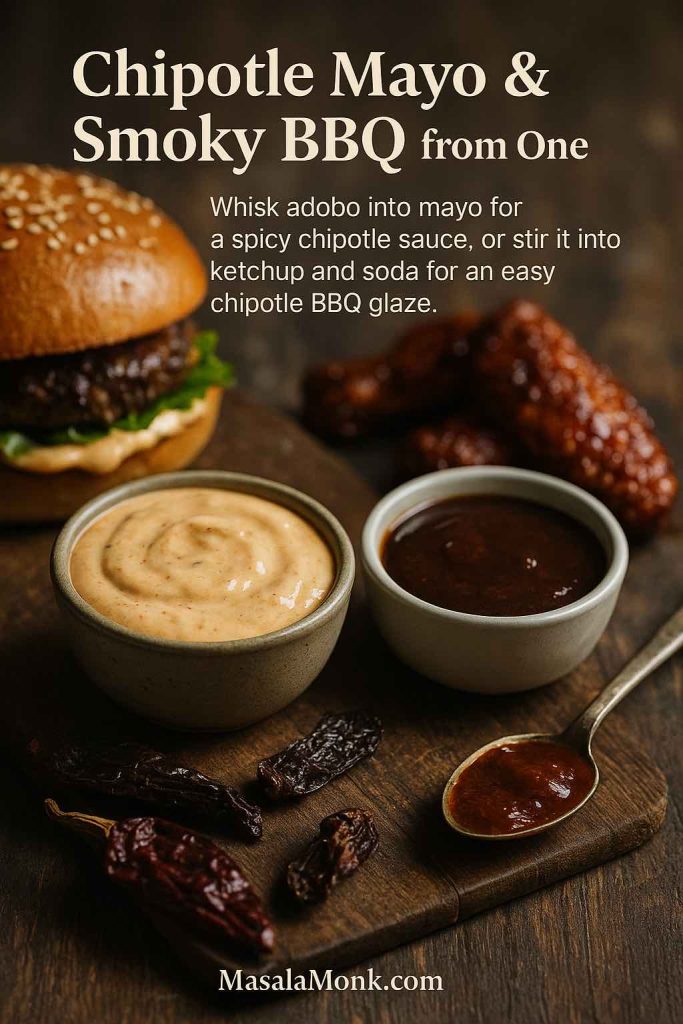
When you’re using canned chipotle in adobo and wondering what to do with the rest of the tin, you might enjoy browsing idea lists like this collection of recipes that use up a can of chipotles in adobo.
Between your homemade adobo chipotle peppers and quick chipotle sauce recipes, you cover a huge chunk of that keyword universe: chili in adobo sauce, peppers in adobo sauce, chipotle chili adobo, chili adobo chipotle, sauce chipotle, adobo sauce chipotle and more, all with genuinely useful recipes.
Also Read: Double Chocolate Chip Cookies – Easy Recipe with 7 Variations
Guajillo Sauce, Ancho Chili Paste and Poblano Pepper Sauce
Moving from aggressive heat to deeper, warmer flavors, it helps to look at the family of Mexican red pepper sauces built on guajillo, ancho and poblano. These sauces often sit between a hot sauce and a stew base, but with a little extra vinegar they slide neatly into pepper sauce territory.
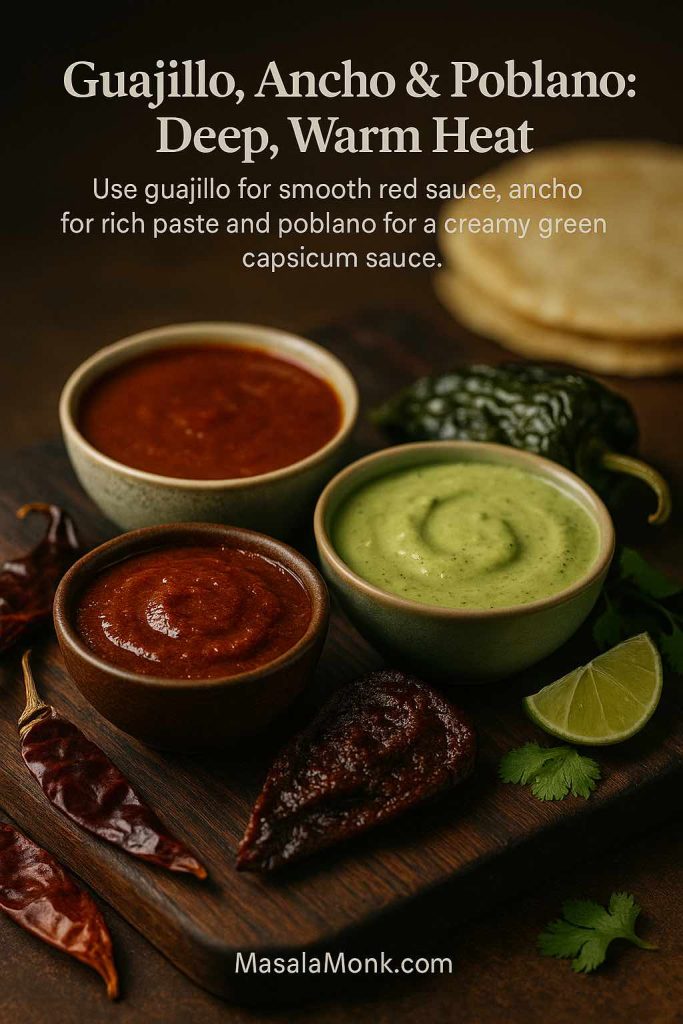
Guajillo Sauce (Chile Guajillo Sauce)
When we talk about Guajillo chilies, they are medium heat, fruity and slightly smoky. A classic guajillo sauce (sometimes called sauce guajillo or chile guajillo sauce) is brick-red and velvety.
Ingredients
- 6 dried guajillo chilies, stems and seeds removed
- 2 dried ancho chilies (optional, for deeper flavor)
- 2 cloves garlic
- ¼ onion
- 1 tomato, roasted or canned
- 500 ml water or stock
- Salt, vinegar to taste
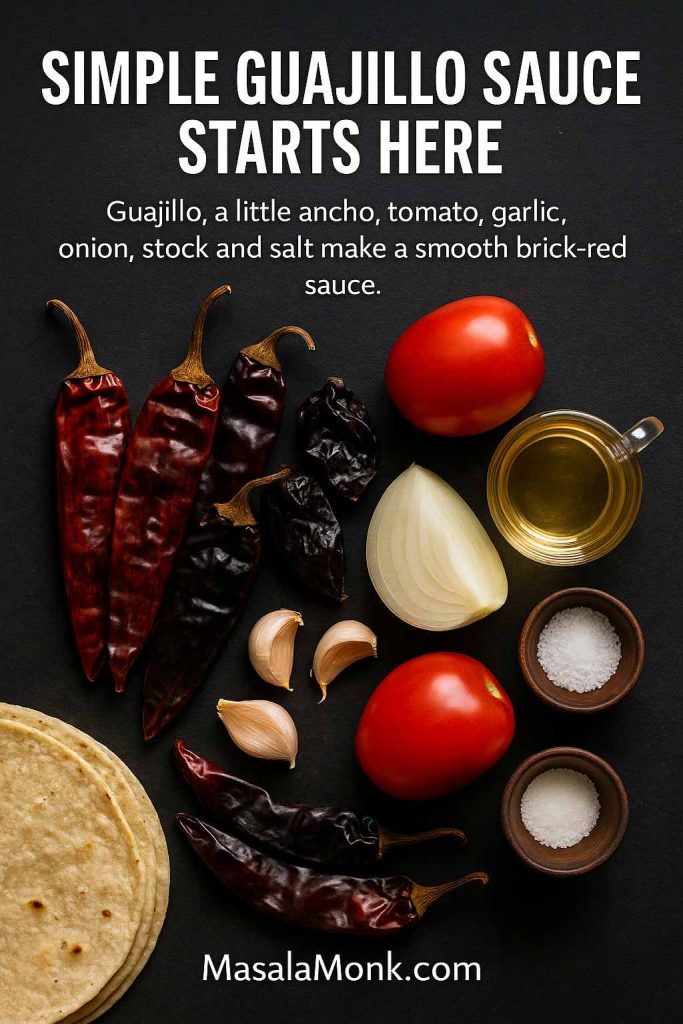
Method
- Lightly toast the guajillo and ancho chilies in a dry pan until fragrant, then soak in just-boiled water for around 20 minutes.
- Blend the softened chilies with garlic, onion, tomato and about 250 ml of soaking liquid until smooth.
- Strain if needed, then simmer the sauce for 15–20 minutes, adding more water if it thickens too much.
- Season with salt and, if you want a sharper edge, a spoon or two of vinegar.
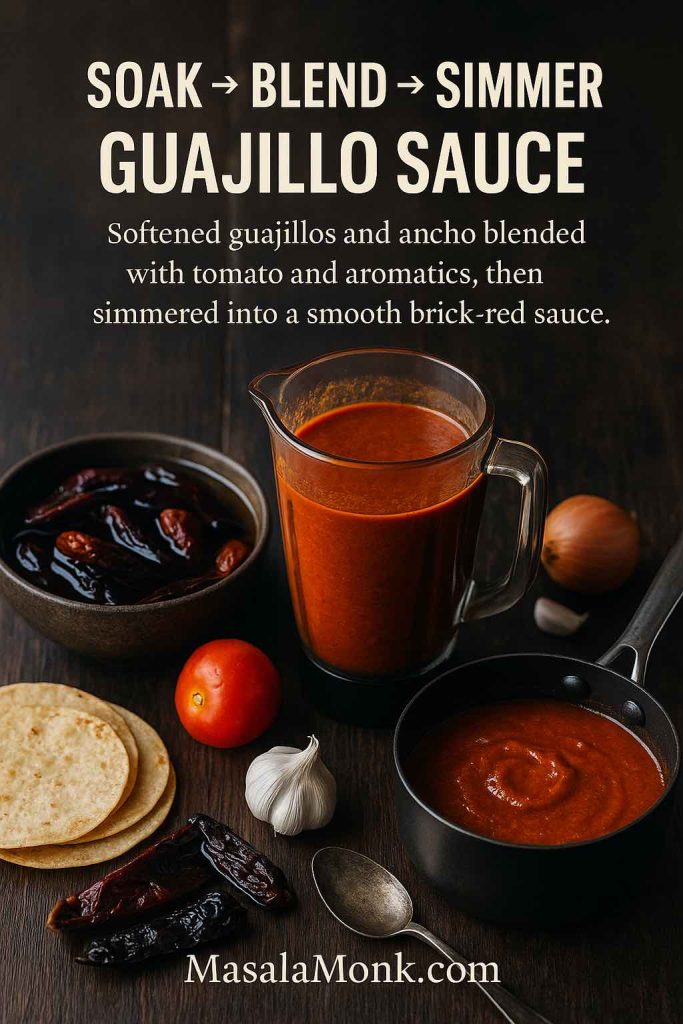
Thickened, this sauce becomes a base for enchiladas, tacos, chili in adobo-style stews and even hatch chili sauce variations. Thinned slightly, it can be used as a red pepper pasta sauce, especially over robust shapes like rigatoni or penne.
Ancho Chile Paste and Ancho Chipotle Sauce
To make ancho chili paste, simply increase the proportion of ancho chilies, cook the blended sauce down further until it’s very thick, then cool and store in a jar. This ancho chile paste can:
- Be whisked with vinegar and a little oil to become ancho sauce for grilled meats.
- Combine with adobo chipotle for a dark, smoky ancho chipotle sauce that works on tacos, roasted vegetables and even pizza.
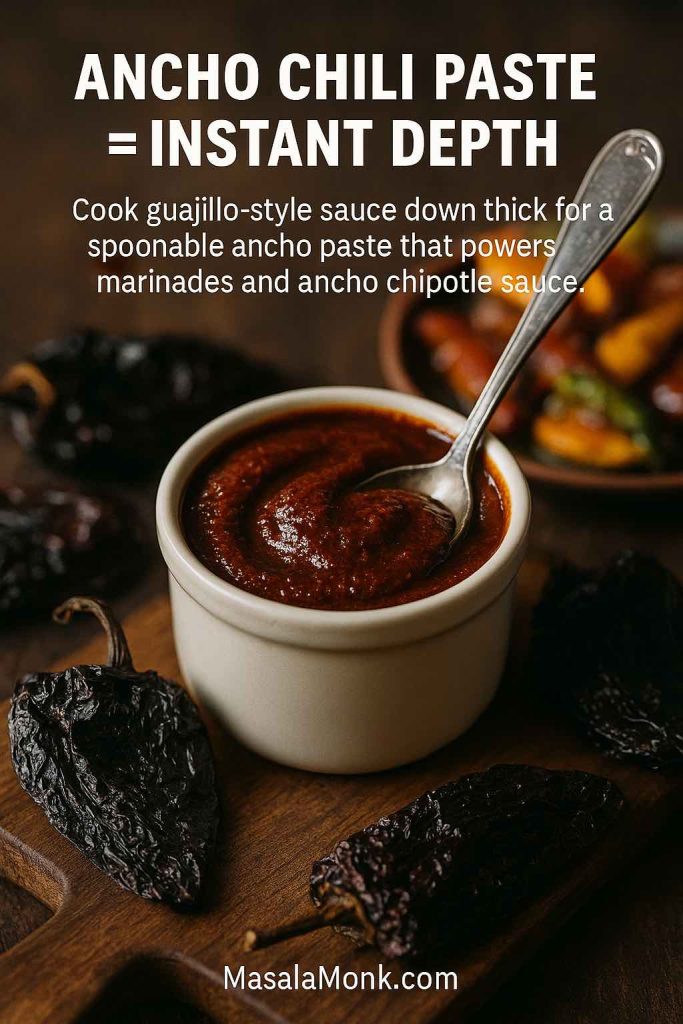
Creamy Poblano Pepper Sauce
For something greener and milder, roasted poblano pepper sauce is an excellent choice.
Ingredients
- 3–4 poblano peppers
- ½ onion
- 2 cloves garlic
- 120 ml cream or cashew cream
- Juice of ½ lime
- Small handful coriander
- Salt
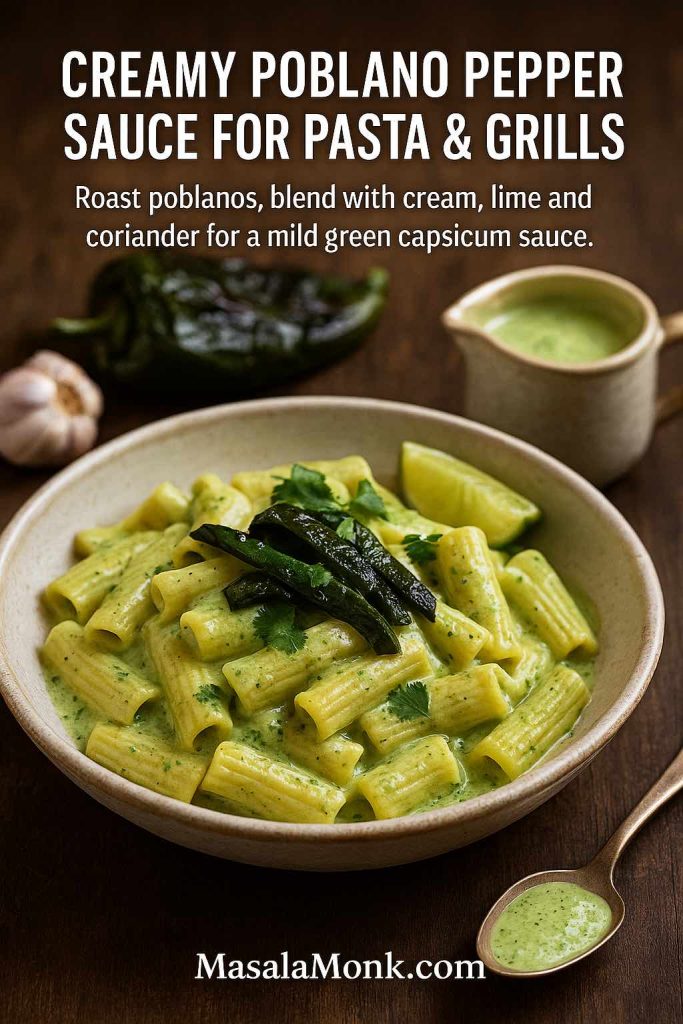
Method
- Roast poblano peppers over an open flame, under the grill or in a very hot oven until blistered. Place them in a covered bowl to steam, then peel and remove seeds.
- Blend the roasted poblanos with onion, garlic, cream, lime and coriander.
- Season with salt and adjust lime juice until it tastes vibrant.
This poblano sauce makes a rich, green capsicum sauce for pasta (think chile poblano spaghetti), grilled chicken or roasted mushrooms.
Also Read: One-Pot Chicken Bacon Ranch Pasta (Easy & Creamy Recipe)
Ají Amarillo Sauce, Ají Verde and Ají Panca
Shifting south, Peruvian aji sauces introduce another dimension to the pepper sauce world. Aji amarillo, aji panca and related peppers bring fruitiness, medium heat and gorgeous color.
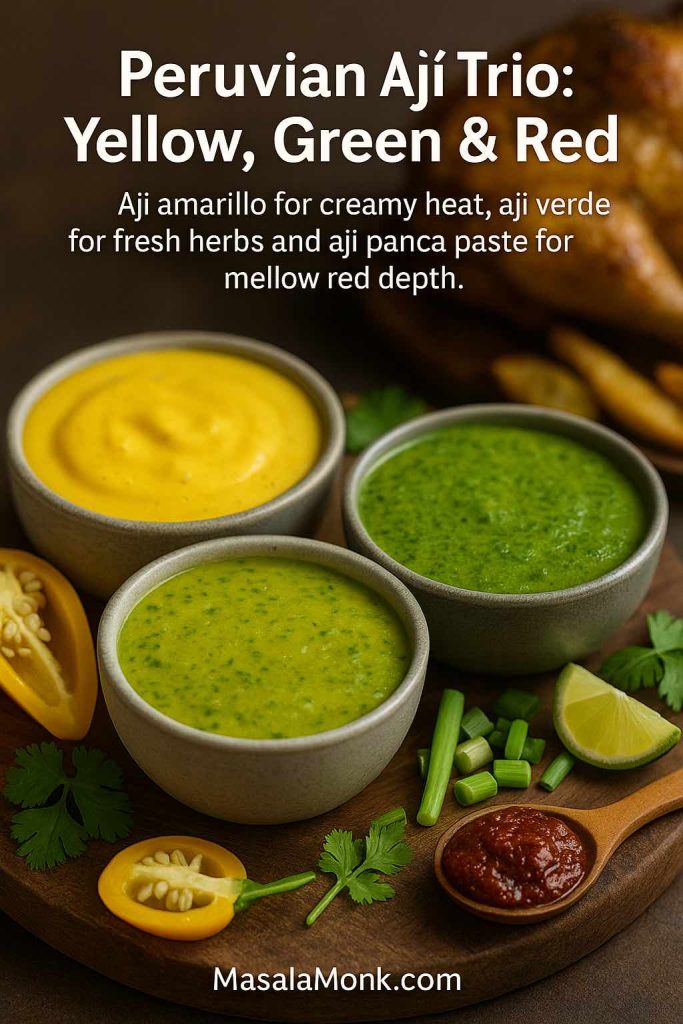
Ají amarillo, often described as the “sunshine chili”, is medium hot and vividly fruity. It appears in many Peruvian sauces and stews. Guides like this one on aji amarillo explain how central it is to Peruvian cooking and why its flavor is so distinctive.
Ají Amarillo Sauce (Peruvian Yellow Sauce)
This aji amarillo sauce, sometimes called Peruvian yellow sauce or peru yellow sauce, is a creamy, tangy dressing for fries, roast potatoes, roast chicken or veggies.
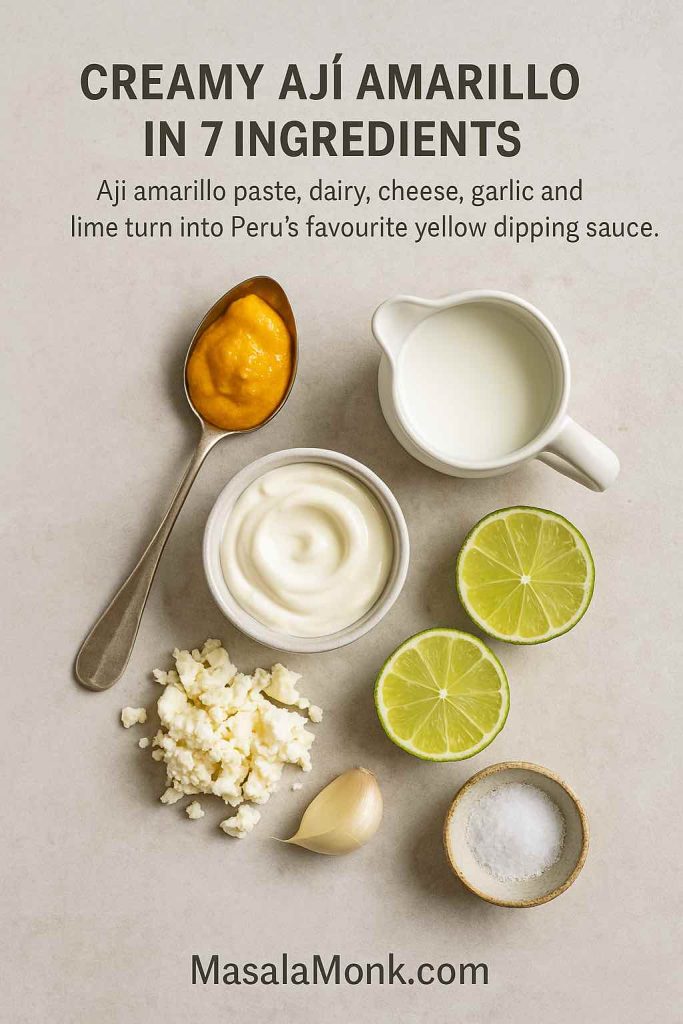
Ingredients
- 3–4 tablespoons aji amarillo paste
- 120 ml mayonnaise or thick yogurt
- 60 ml milk or evaporated milk
- 50 g queso fresco or feta
- 1 clove garlic
- Juice of ½–1 lime
- Salt
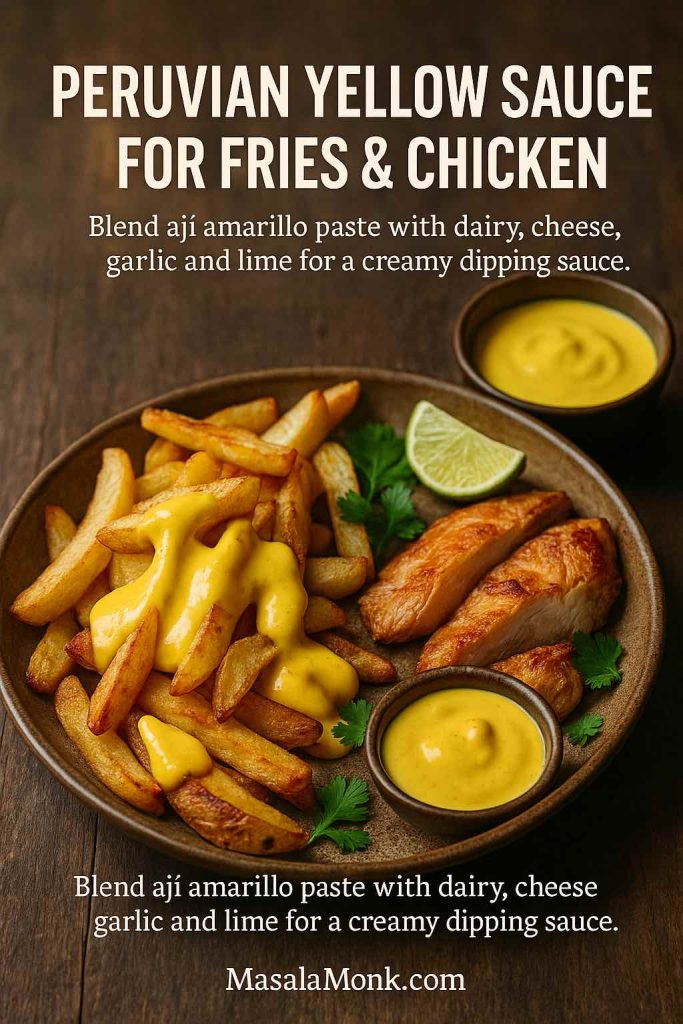
Method
- Add ají amarillo paste, mayo, milk, cheese, garlic and lime juice to a blender.
- Blend until completely smooth and pale yellow.
- Adjust thickness with extra milk and season with salt.
The result is a bright, creamy aji pepper sauce that hits different notes from jalapeno ranch or habanero cream sauce yet plays a similar role: drizzled over bowls, fries, roasted vegetables and grilled meats.
Ají Verde (Green Ají Pepper Sauce)
Ají verde is the herb-forward cousin of yellow aji sauce. To make it, you can:
- Blend ají amarillo paste with coriander, spring onion, lime juice, garlic, oil, a little mayo or yogurt and salt.
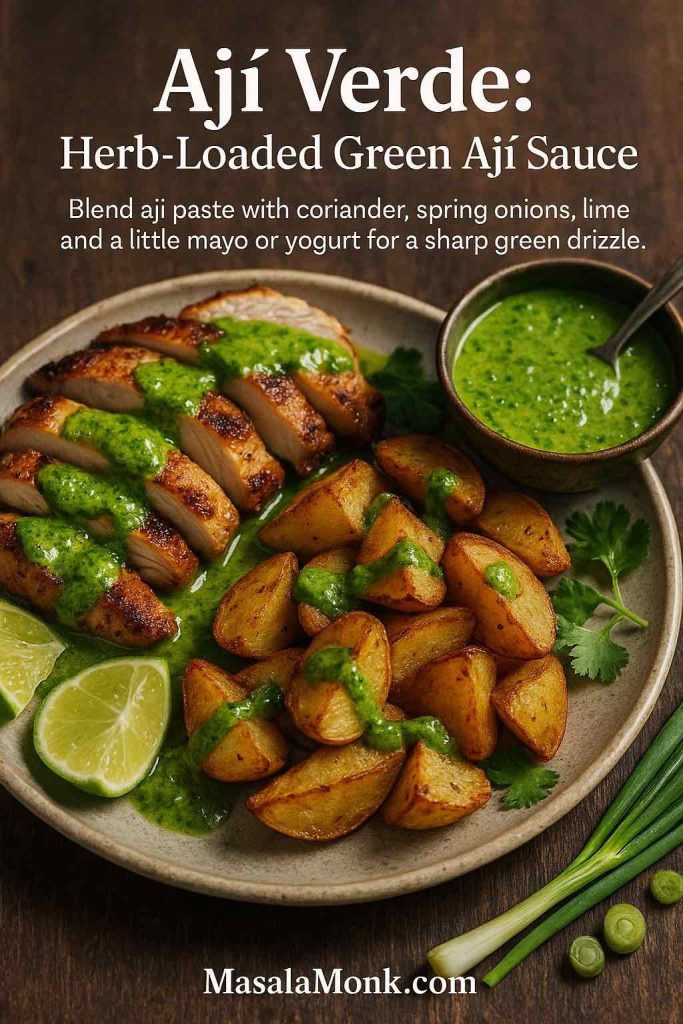
The result is a vibrant green aji chili sauce that pairs beautifully with grilled meats, bread or roast potatoes, in the same way a bright chimichurri does for steak.
Ají Panca Paste and Sauce
Ají panca is milder, deep red and slightly raisin-like. Turning it into aji panca paste is as simple as simmering aji panca, garlic and onion with a splash of vinegar, then blending until smooth.
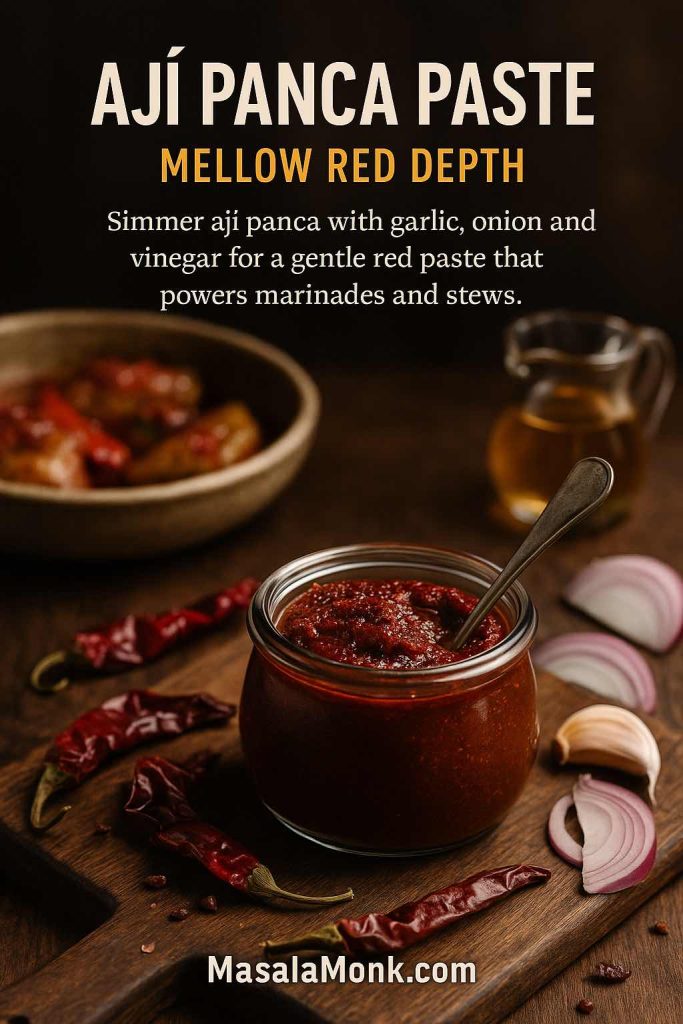
This paste can be used:
- As a marinade base for grilled vegetables or meats.
- As a softer, less fiery red aji pepper sauce when thinned with stock and a little lime juice.
Together, ají amarillo sauce, ají verde and ají panca paste give you an entire Peruvian pepper sauce family that’s distinct from Mexican or Caribbean styles but equally addictive.
Also Read: Authentic Louisiana Red Beans and Rice Recipe (Best Ever)
Roasted Red Pepper Sauces: Romesco, Ajvar and Sweet Capsicum
Not all pepper sauces are about heat. Some focus on sweetness, smokiness and richness while still being robustly pepper-forward. This family includes romesco sauce, ajvar, roasted red pepper pesto and a variety of bell pepper pasta sauces.
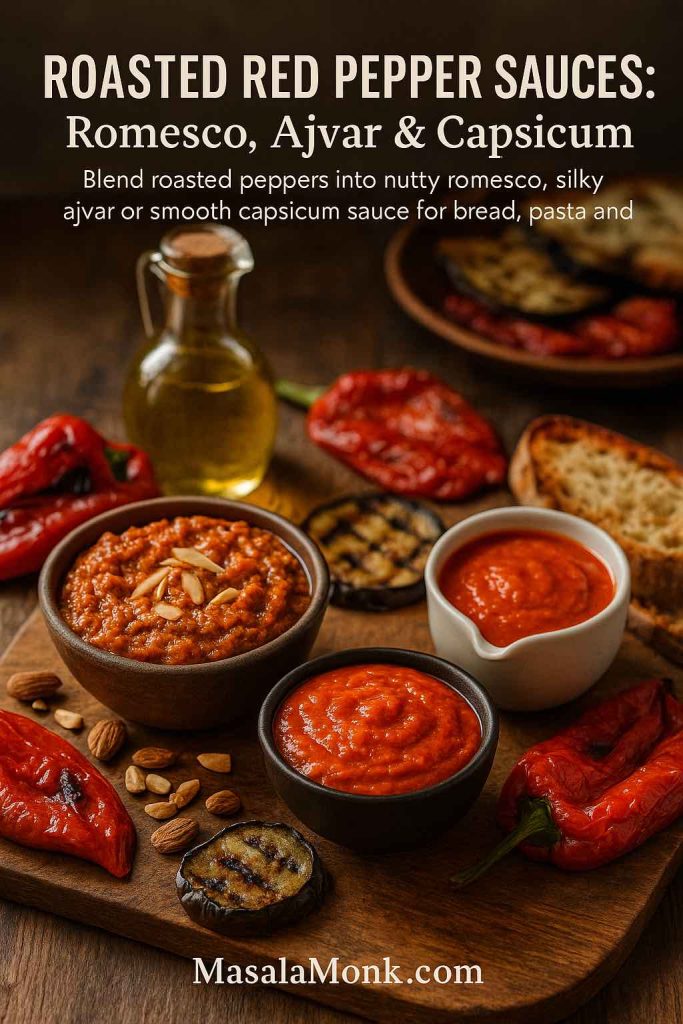
Romesco Sauce Recipe
Romesco comes from Catalonia and brings together roasted red peppers, tomato, nuts, bread and olive oil. It’s thick, rust-colored and amazing with grilled vegetables, fish, eggs or crusty bread.
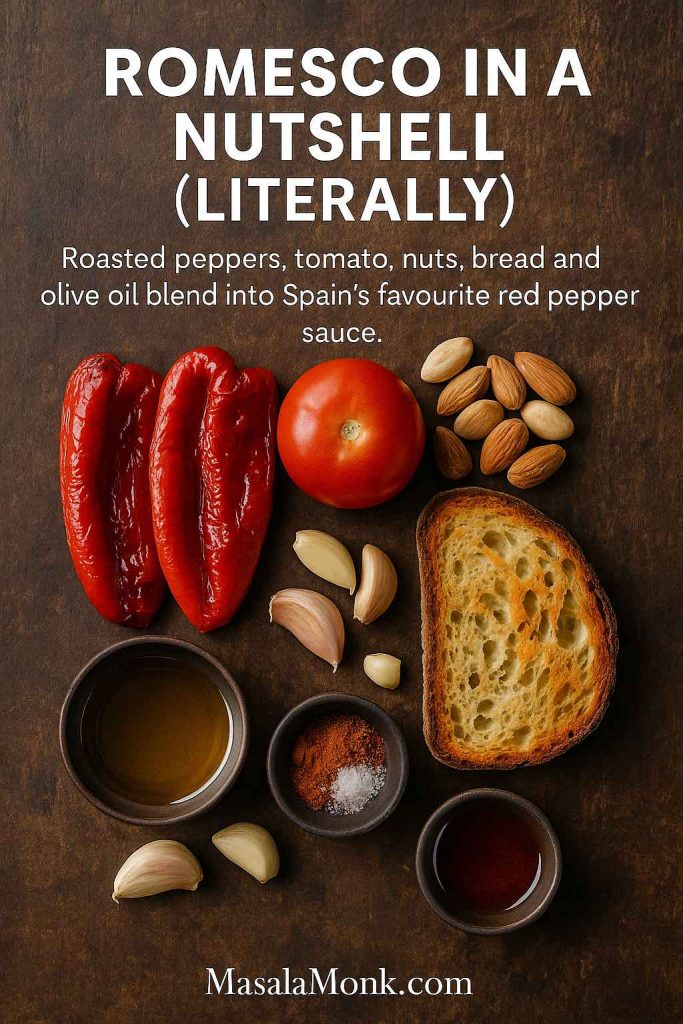
Ingredients
- 2 large roasted red bell peppers (or 1 cup from a jar)
- 1 tomato, roasted or canned
- 30 g toasted almonds or hazelnuts
- 1 slice stale bread, toasted
- 1–2 cloves garlic
- 2–3 tablespoons olive oil
- 1–2 teaspoons sherry vinegar or red wine vinegar
- Smoked paprika, salt and pepper
Method
- Combine peppers, tomato, nuts, bread and garlic in a food processor.
- Add olive oil and vinegar, then pulse until thick and slightly coarse.
- Season with smoked paprika, salt and pepper. Adjust vinegar until it tastes bright.
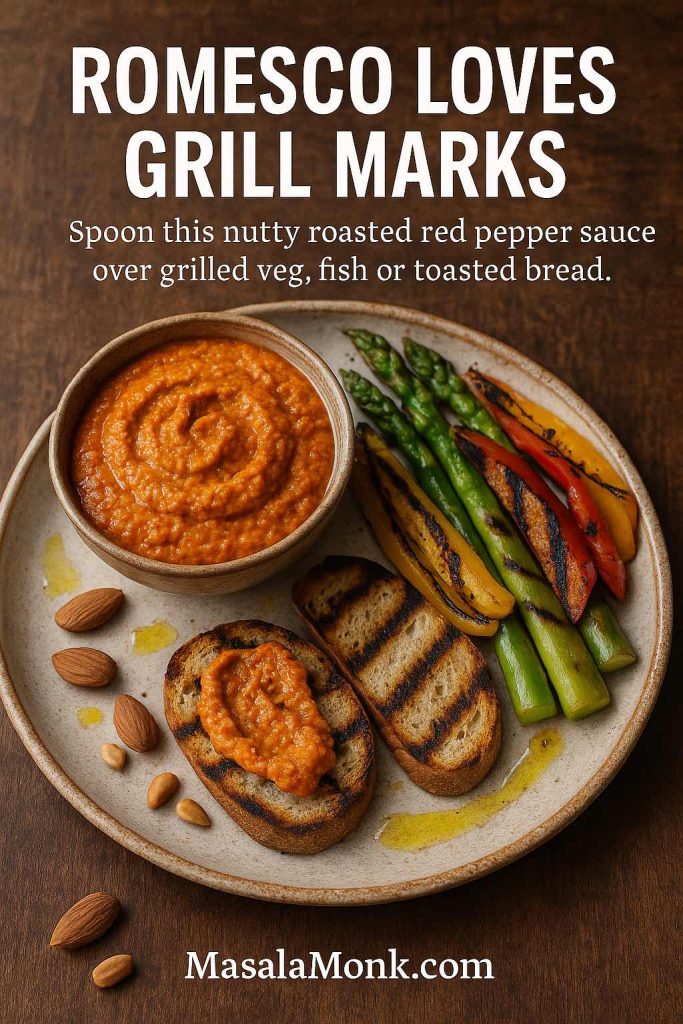
For a deeper dive into traditional methods, including the use of specific Spanish dried peppers, there are detailed guides such as this romesco sauce recipe.
Ajvar: Balkan Roasted Red Pepper Spread
Ajvar sauce is a Balkan favorite made from roasted red peppers and often eggplant. It’s smoother than romesco, typically without nuts or bread, and is used as a spread or dip.
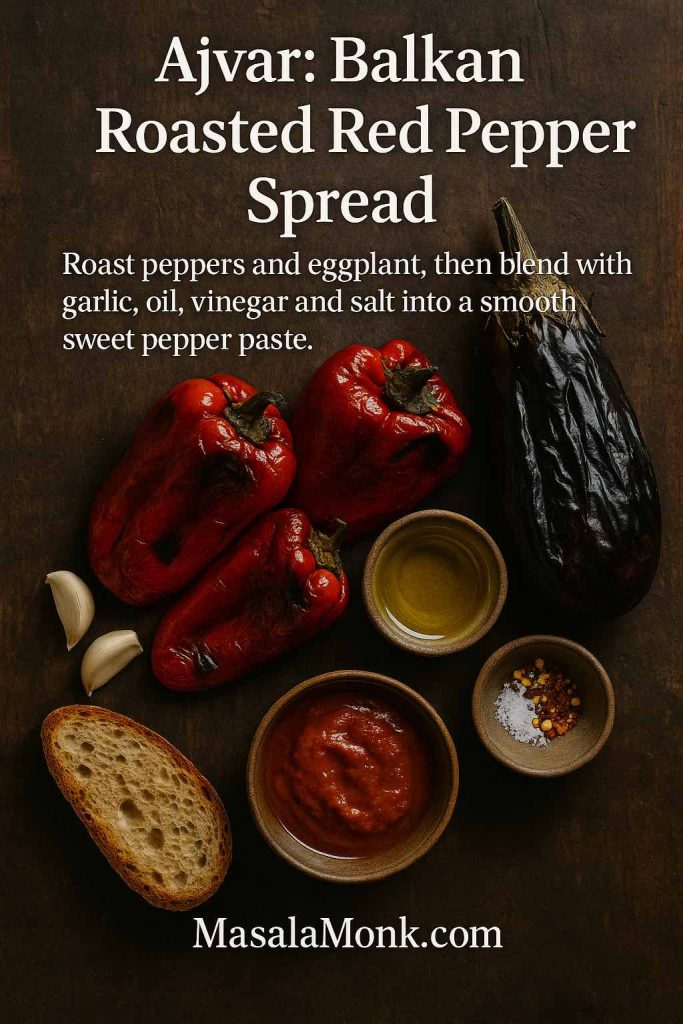
To make a simple ajvar red pepper spread:
- Roast red peppers and eggplant until very soft.
- Peel, drain excess liquid, then blend with garlic, a little vinegar, olive oil and salt.
- Cook it down in a pan until thick and glossy.
This sweet pepper paste works as a sandwich spread, mezze dish or pasta toss.
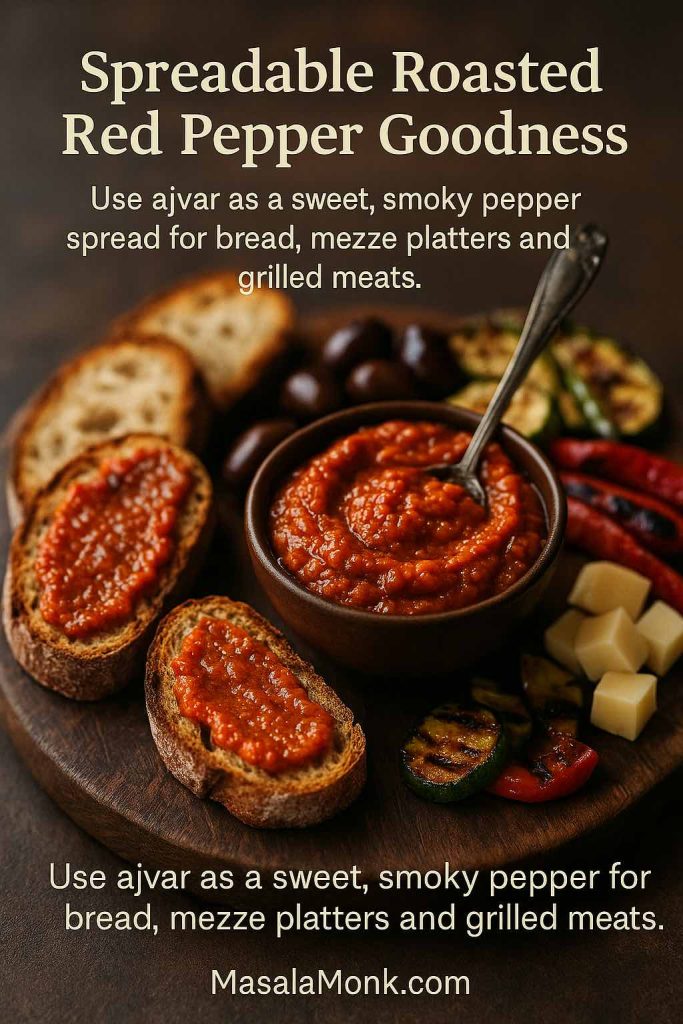
Roasted Red Pepper Pasta Sauce and Bell Pepper Coulis
Roasted bell peppers can easily become:
- A smooth bell pepper pasta sauce blended with cream or cashew cream, garlic and Parmesan, echoing some of the comforting notes from sauces like Alfredo and béchamel.
- A red pepper pesto (with nuts, cheese, olive oil) for tossing with pasta, much like the basil-based versions in pesto recipe collections.
- A simple bell pepper coulis: a thin, silky puree splashed around grilled fish or vegetables.
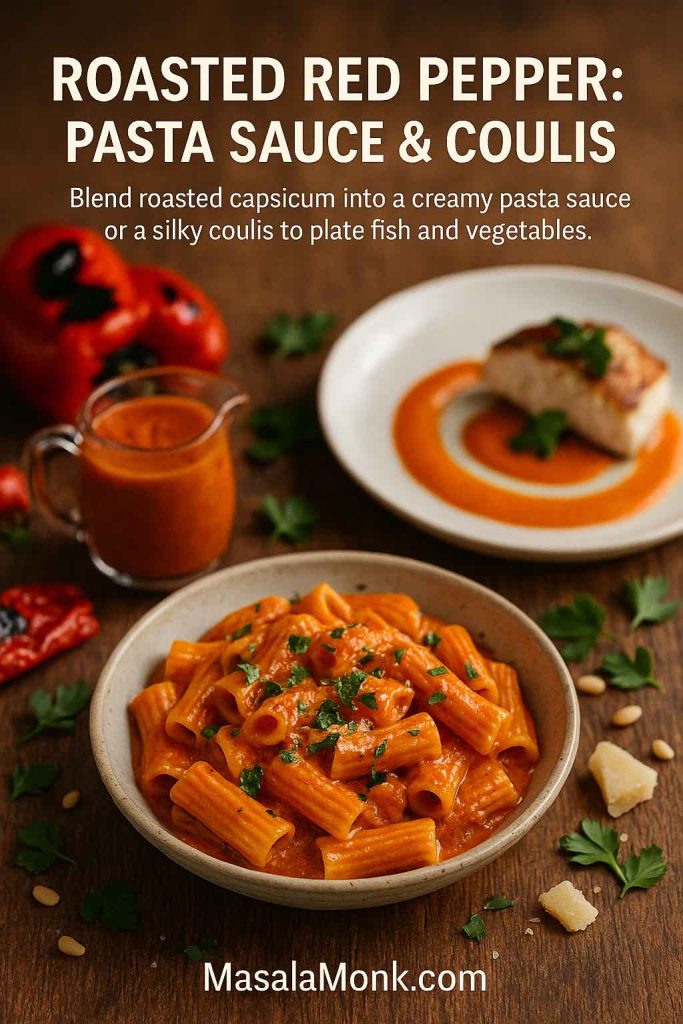
These roasted red pepper sauces give you a way to highlight capsicum flavor when you don’t want too much heat, while still playing nicely alongside hotter sauces like habanero or chipotle.
Asian Chili Oil and Chili Pepper Sauce Recipes
When you move eastward, chili takes on new shapes. Instead of vinegar-heavy hot sauce, you often find chili oil, chili pastes and complex stir-fry sauces. These still count as pepper sauces in the broad sense, and they’re essential in many kitchens.
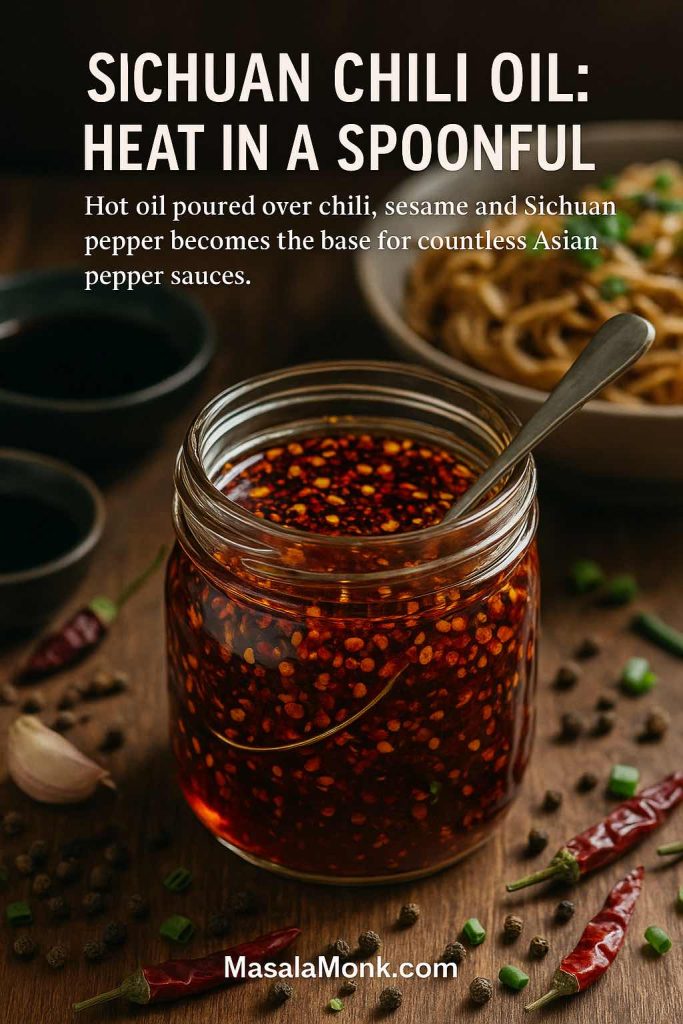
Sichuan Chili Oil
Szechuan chili oil – or Sichuan chili oil – is essentially a hot pepper sauce built in oil rather than vinegar. It carries crunchy chili flakes, sesame seeds and the numbing tingle of Sichuan peppercorns.
Basic idea
- Warm neutral oil with ginger, garlic, scallions, star anise and Sichuan peppercorn until fragrant.
- Strain the hot oil over a bowl of chili flakes, sesame seeds and a pinch of salt and sugar.
- Stir and let cool.
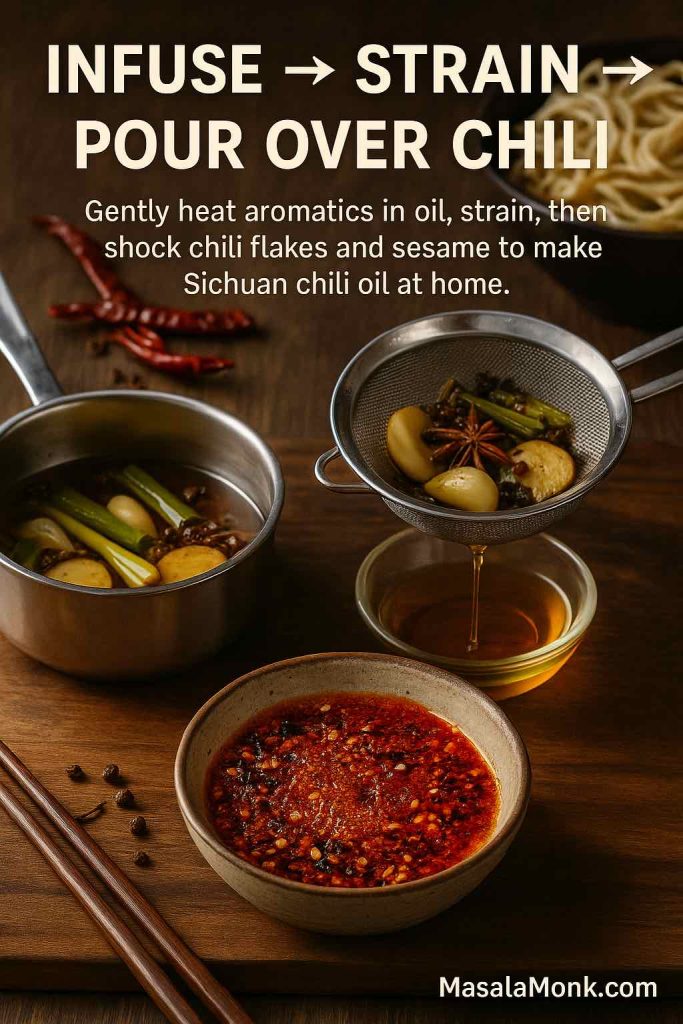
A very detailed walkthrough, including specific temperatures and variations, can be found in this chili oil guide.
From this one condiment, you can make:
- Chinese hot pepper sauce by mixing chili oil with soy sauce, black vinegar, garlic and sugar as a dipping sauce for dumplings.
- Japanese-style chili oil, lighter and often more sesame-forward, for ramen and gyoza.
- Asian hot chili oil variations with dried shrimp, fermented black beans or peanuts.
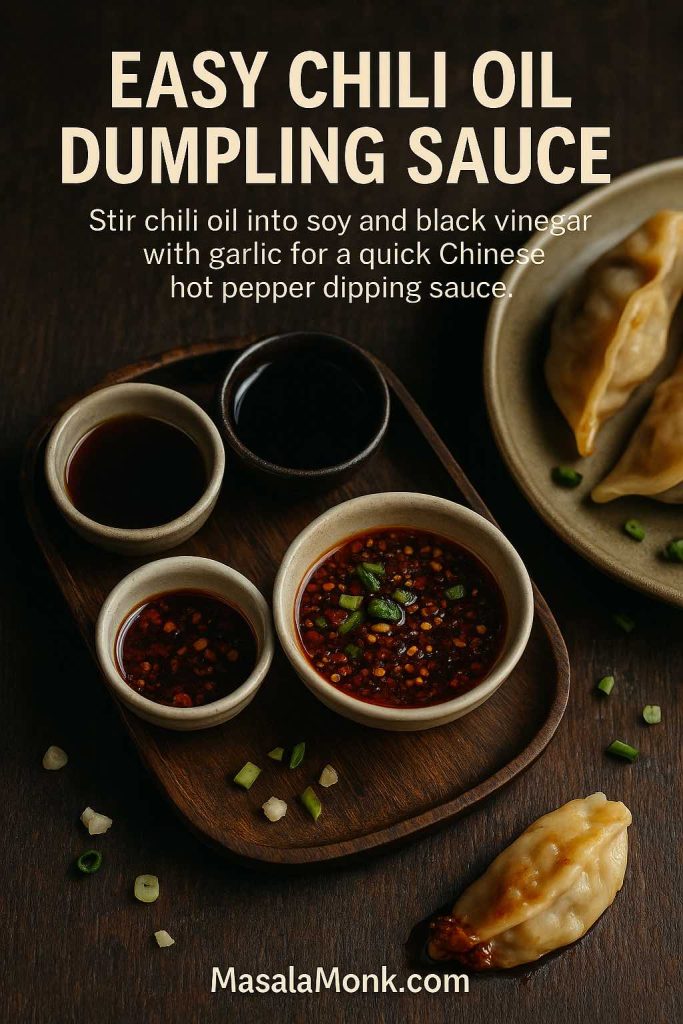
In Indian kitchens, similarly punchy condiments appear in forms like thecha – a coarse, fiery mixture of green chilies, garlic and oil – which you can explore in recipes such as MasalaMonk’s tempting thecha.
These different takes on chili pepper sauce show how versatile the basic combination of pepper, fat, salt and aromatics can be.
Also Read: Sheet Pan Chicken Fajitas Recipe (Easy One-Pan Oven Fajitas)
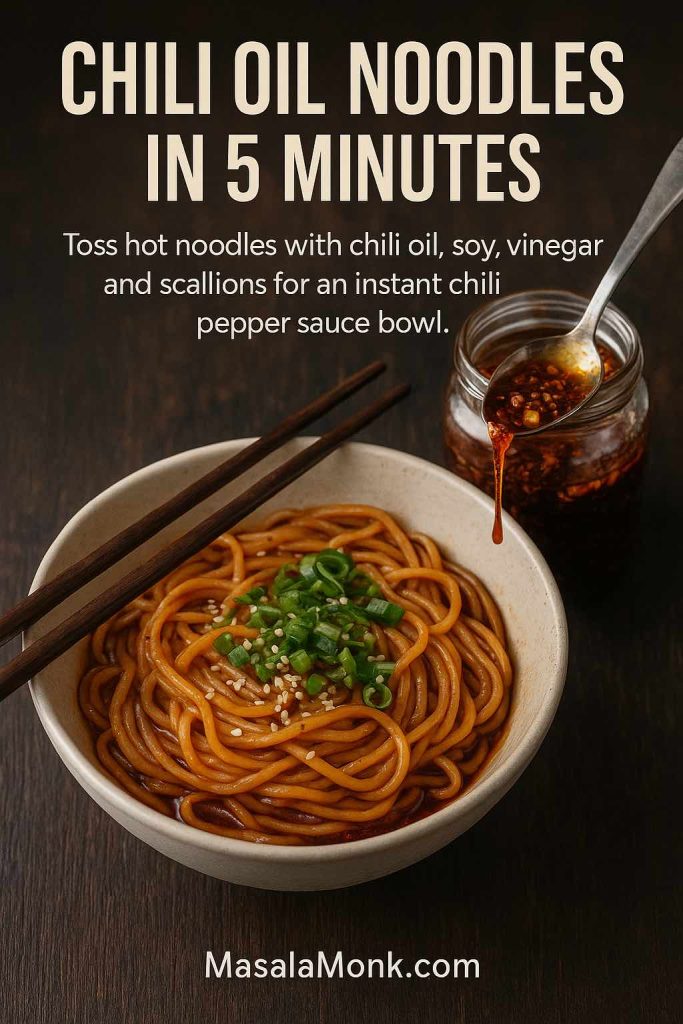
Peppercorn Sauce: Green, Black and Brandy Variations
Finally, pepper sauce doesn’t always mean chilies. Black and green peppercorns form the backbone of beloved steak sauces, gravies and dressings. These sauces are milder in heat but intense in aroma, and they round out the larger pepper sauce family.
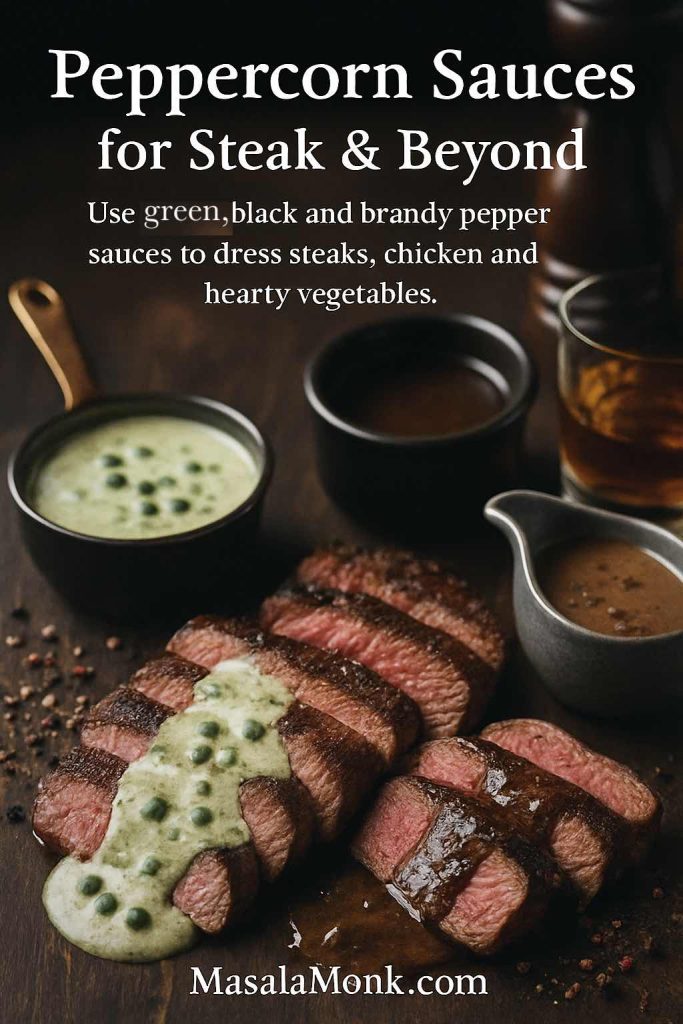
Classic Green Peppercorn Sauce
Green peppercorn sauce is a restaurant favorite, usually served with steak or grilled chicken. It’s creamy, slightly tangy and warmly peppery rather than searing.
Ingredients
- 2 tablespoons butter
- 1 small shallot, finely chopped
- 2 tablespoons green peppercorns in brine, lightly crushed
- 60 ml brandy (optional but traditional)
- 120 ml stock
- 120 ml cream
- Salt
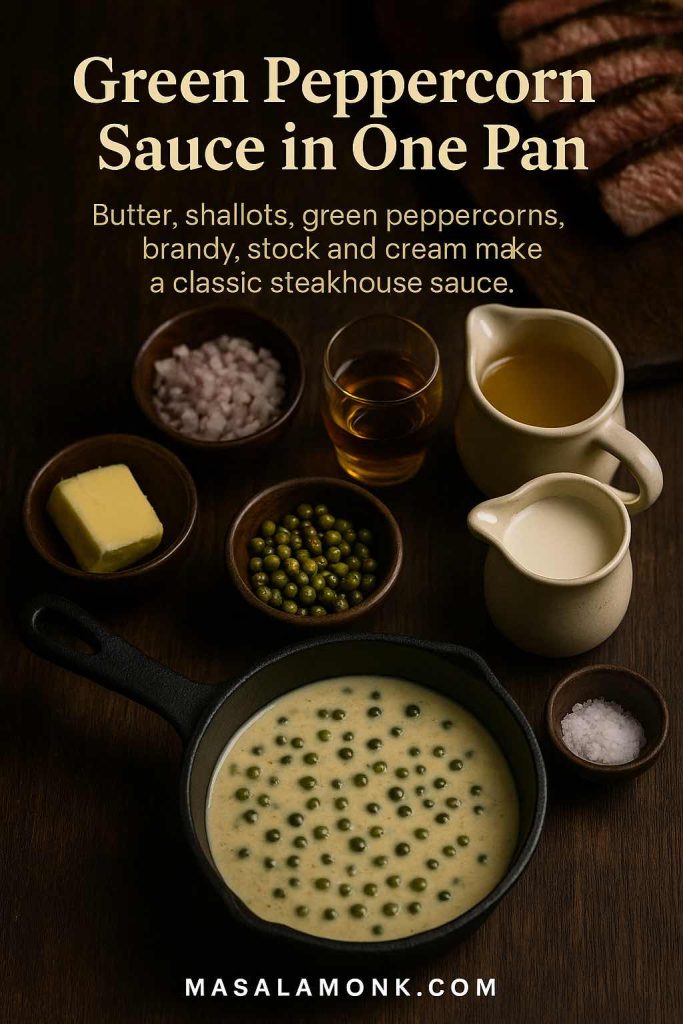
Method
- In a pan, melt butter and gently cook the shallot until translucent.
- Stir in the green peppercorns and cook for another minute.
- Pour in brandy, let it bubble for a minute, then add stock. Simmer to reduce slightly.
- Add cream and simmer until the sauce thickens enough to coat the back of a spoon.
- Season with salt.
This green peppercorn sauce is perfect over beef steak with black pepper sauce-style rubs, grilled tofu or roasted vegetables.
Black Pepper Steak Sauce and Peppercorn Gravy Recipe
For a black peppercorn sauce recipe, you can:
- Swap green peppercorns for coarsely crushed black peppercorns.
- Add a splash of soy sauce and perhaps oyster sauce to push it toward an Asian black pepper Chinese sauce for stir-fried beef black pepper or beef steak pepper sauce.
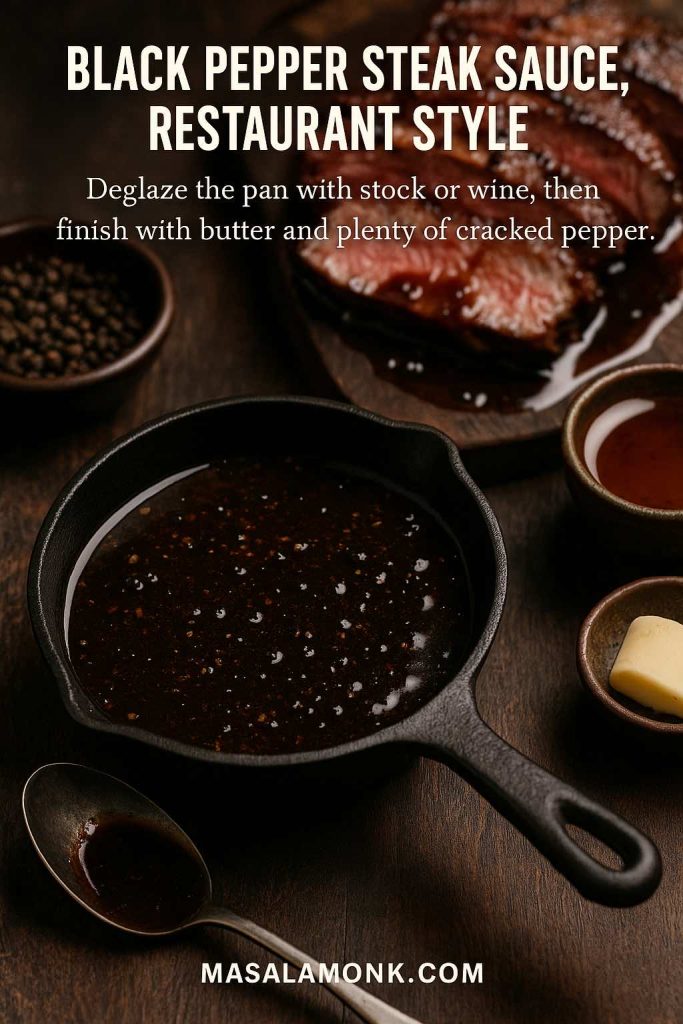
Meanwhile, if you extend the stock and thicken with a little flour or cornstarch instead of cream, you get peppercorn gravy, ideal for mashed potatoes, roasts and pies.
Creamy Pepper Sauce Recipe and Peppercorn Dressing
A simple creamy pepper sauce recipe can be mashed together as follows:
- Deglaze a pan with stock or wine after searing steak or chicken.
- Add cream, cracked black pepper and a small spoon of mustard, then simmer until thickened.
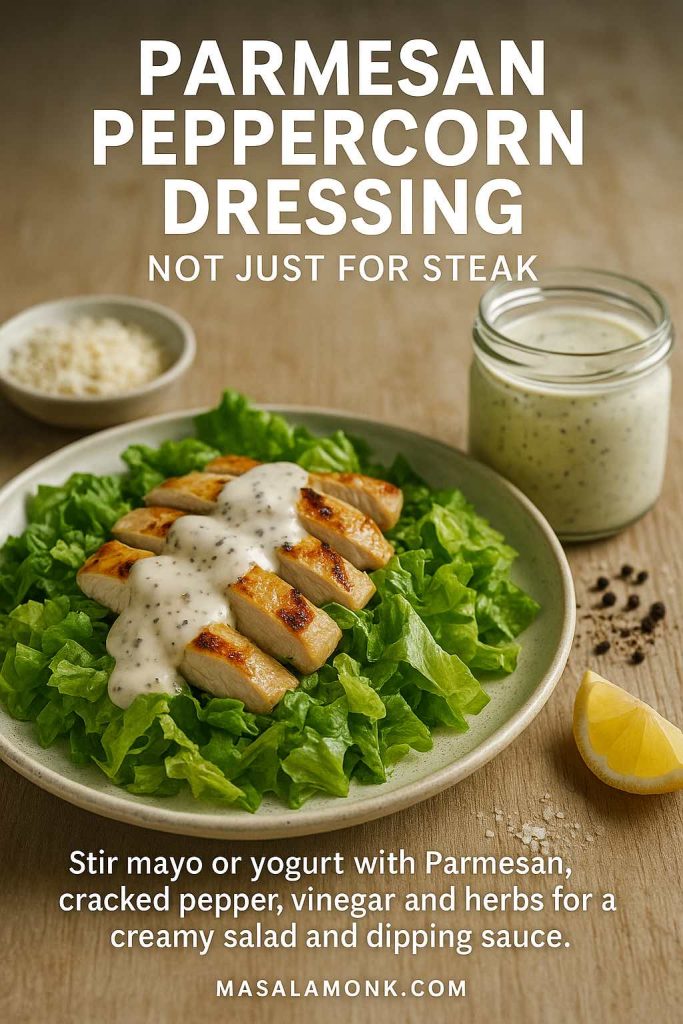
For cold dishes and salads, a Parmesan peppercorn dressing mixes mayonnaise or yogurt with grated Parmesan, cracked pepper, vinegar and herbs. It makes a great foil for spicy fried chicken, buffalo cauliflower, and all the other places you might normally use ranch, just as Greek tzatziki variations offer a refreshing, protein-rich alternative.
Also Read: Whole Chicken in Crock Pot Recipe (Slow Cooker “Roast” Chicken with Veggies)
Bringing It All Together
Once you have a few of these pepper sauce recipes under your belt, it becomes easier to improvise your own. The logic that makes jalapeno pepper sauce work is not so different from the logic behind aji amarillo sauce or a simple chili pepper sauce for noodles.
You can:
- Grab a handful of fresh chilies and make a quick hot pepper sauce with vinegar, garlic and salt.
- Use dried guajillo, ancho or arbol chile for smoother, earthier guajillo sauce or ancho chili paste.
- Blend roasted bell peppers and nuts into romesco, or roasted peppers and eggplant into ajvar.
- Turn mango, pineapple or peach into sweet hot pepper sauce with habanero or scotch bonnet.
- Switch to oil-based chili pepper sauce with Szechuan chili oil.
- Move beyond chili entirely and make silky peppercorn gravy or brandy peppercorn sauce.
Alongside these, you may want non-pepper sauces in your repertoire as well. Creamy white sauces like béchamel for lasagna, rich meat sauces like bolognese, herb-forward green sauces like pesto and bright, tangy chutneys such as sautéed green chillies or peanut chutney all give you ways to match any dish and mood.
However you combine them, pepper sauces bring intensity, color and contrast to the table. Once you start keeping a couple of bottles or jars – maybe a jalapeno pepper sauce, a mango habanero hot sauce, a smoky chipotle in adobo and a romesco sauce – you’ll notice how often you reach for them. In the end, that’s the real power of a good pepper sauce recipe: it turns ordinary food into something you remember, again and again.
Also Read: Cheesy Chicken Broccoli Rice – 4 Ways Recipe (One Pot, Casserole, Crockpot & Instant Pot)
FAQs
1. What is a pepper sauce recipe?
It’s any sauce where peppers are the main flavor, usually blended with acid (vinegar or citrus), salt and sometimes a bit of sweetness. It can be a thin hot pepper sauce recipe, a chunky jalapeno salsa, a smooth aji pepper sauce or even a creamy peppercorn sauce for steak.
2. How is pepper sauce different from hot sauce?
Generally, “hot sauce” means a thin, vinegar-heavy chili sauce like cayenne hot pepper sauce or Louisiana hot sauce. “Pepper sauce” is a bigger family that also includes creamy pepper sauce, romesco sauce, guajillo sauce, ajvar, aji amarillo sauce and peppercorn gravy.
3. Which pepper is best for a basic hot pepper sauce?
For a classic vinegar hot pepper sauce, medium-hot, thin-walled peppers like cayenne, serrano or generic “red chilies” work best because they blend smoothly and deliver clean heat without overwhelming flavor.
4. What’s the difference between jalapeno pepper sauce and habanero hot sauce?
Jalapeno hot sauce is usually milder and greener in flavor, ideal for everyday use. Habanero hot sauce and habanero chili sauce are much hotter and more fruity, so they’re often used in smaller amounts or combined with mango, pineapple or cream.
5. How spicy is scotch bonnet hot sauce compared to habanero?
Scotch bonnet chili usually has a similar heat level to habanero, but it tastes a bit more tropical and floral. Therefore, scotch bonnet hot sauce and Jamaican hot pepper sauce feel fiery like habanero sauce but with a distinct island-style character.
6. How can I make my pepper sauce milder?
First, remove seeds and membranes before blending. Also, choose gentler peppers like bell pepper, banana pepper or jalapeno instead of habanero or ghost pepper. Finally, add more acid, sweetness or cream to soften the burn in any pepper sauce recipe.
7. How do I make a thicker, creamier pepper sauce?
Cook the sauce down to reduce liquid, or blend in creamy ingredients like yogurt, cream, cheese or mayo. That’s how you move from a thin jalapeno pepper sauce to a cheesy jalapeno sauce, creamy habanero sauce or rich brandy peppercorn sauce.
8. How long does homemade pepper sauce last in the fridge?
A very acidic hot pepper sauce recipe made with lots of vinegar and salt can last several months refrigerated in clean bottles. In contrast, creamy sauces, fruit-heavy mixes like mango and habanero sauce or pineapple habanero salsa are best used within a week or two.
9. Do I need to cook my pepper sauce or can it be raw?
You can do both. Raw sauces like fresh jalapeno salsa or a raw aji verde taste bright and grassy. Cooked sauces such as guajillo sauce, chili in adobo sauce or roasted red pepper sauce taste deeper and sweeter, with softer heat.
10. What is chipotle pepper in adobo sauce, exactly?
It’s smoked, dried jalapeno (chipotle) simmered in a tomato, vinegar, garlic, sugar and spice mixture called adobo sauce. The result is soft chilies in a rich, smoky, tangy sauce used for chipotle hot sauce, chipotle mayo and smoky stews.
11. What can I do with leftover chipotle in adobo?
Chop it into chili, taco fillings, scrambled eggs, soups or pepper steak sauce. Alternatively, blend with mayo or yogurt for chipotle sauce, stir into BBQ sauce, or add a spoon to guajillo sauce and ancho chili paste for extra smokiness.
12. What is aji amarillo, and why is it popular in sauces?
Aji amarillo is a Peruvian chili with medium heat and bright, fruity flavor. It’s used as aji amarillo chili paste and blended into aji amarillo sauce or Peruvian yellow aji sauce, which are creamy, tangy and perfect for fries, rice and grilled meats.
13. How is aji verde different from aji amarillo sauce?
Aji amarillo sauce is yellow, creamy and cheese-based, while aji verde is greener and herbier. Aji verde usually combines aji paste with coriander, spring onions, lime and oil, creating a fresher, sharper aji chili sauce.
14. What is guajillo sauce used for?
Guajillo sauce, or chile guajillo sauce, is a smooth red pepper sauce made from dried guajillo chilies. It’s commonly used on enchiladas, tacos, rice bowls and stews, and it can even double as a smoky red pepper pasta sauce when thinned.
15. How does ancho chili paste differ from guajillo sauce?
Ancho chili paste is thicker and deeper, with raisiny sweetness, while guajillo sauce is usually lighter and more tomato-forward. Ancho sauce or ancho chipotle sauce often ends up as a marinade or glaze, whereas guajillo sauce is more pourable.
16. What is romesco sauce, and is it really a pepper sauce?
Romesco sauce recipe combines roasted red pepper, tomato, nuts, bread, garlic and olive oil. It’s more of a thick dip than a hot sauce, yet it’s still a pepper sauce because roasted capsicum is the star flavor and the base for the whole mixture.
17. What is ajvar, and how is it different from romesco?
Ajvar is a Balkan roasted red pepper spread usually made from red peppers and eggplant, blended with oil and garlic. It is smoother and simpler than romesco, with no nuts or bread, and it leans more toward sweet pepper sauce than chili heat.
18. What is Szechuan chili oil, and how is it used?
Szechuan chili oil (Sichuan chili oil) is hot oil poured over chili flakes, garlic, sesame and Sichuan peppercorn. You use it to top noodles, dumplings, stir-fries and rice bowls, or to form the base of Chinese hot pepper sauce for dipping.
19. How is sweet chili pepper sauce different from regular hot sauce?
Sweet chili pepper sauce usually combines chilies with sugar or honey and often a little starch for gloss. It’s sticky, sweet and gently hot, unlike sharp vinegar hot sauce. It also glazes fried foods and wings beautifully.
20. What’s the difference between green pepper sauce and red pepper sauce?
Green pepper sauces often use jalapeno, serrano, green habanero or green peppercorns, giving fresh, grassy or zesty flavors. Red pepper sauces usually rely on ripe red chilies, guajillo, ancho or roasted red bell pepper, bringing deeper sweetness and smokier notes.
21. Can I make pepper sauce without vinegar?
Certainly. Instead of vinegar, you can use citrus juice, tomato, yogurt, cream or stock. Aji amarillo sauce, creamy jalapeno sauce, lemon pepper sauce, green peppercorn sauce and many romesco and ajvar variations skip vinegar or keep it minimal.
22. What is pepper vinegar sauce, and when should I use it?
Pepper vinegar sauce is simply whole or sliced chilies steeped in vinegar with salt, sometimes garlic. You splash it over beans, greens, rice and fried foods, much like a very thin hot pepper sauce, but with whole chilies still visible in the bottle.
23. Which pepper sauces recipes are best for wings?
Mango habanero wing sauce, classic cayenne hot pepper sauce with butter, garlic chili pepper sauce, sweet chili pepper sauce and smoky chipotle pepper sauce all work brilliantly on wings. Creamy options like ghost pepper ranch or jalapeno ranch dipping sauce also pair well on the side.
24. Which pepper sauces work best with pasta?
Romesco sauce, roasted red pepper pasta sauce, capsicum pasta sauce, bell pepper pasta sauce, ancho chipotle sauce and creamy poblano pepper sauce all cling nicely to pasta. For a peppercorn twist, creamy pepper sauce or peppercorn gravy can double as a rich pasta coating.
25. Can pepper sauce be vegetarian or vegan?
Yes, easily. Most vinegar-based hot sauces are naturally vegan. Romesco sauce, guajillo sauce, ajvar, chili oil homemade, African chilli sauce, basic aji pepper paste and many roasted capsicum sauces are also plant-based unless you add cheese or cream.
26. How do I safely handle very hot peppers like Carolina Reaper or ghost pepper?
Wear gloves, avoid touching your face, and use good ventilation. Work with tiny amounts in your pepper sauce recipes, and consider diluting them with fruit or dairy, as in ghost chili hot sauce with mango or ghost pepper wing sauce cut with butter and honey.
27. What’s the benefit of fermenting pepper sauce instead of just cooking it?
Ferments develop a more complex, tangy flavor and natural umami. Fermented hot pepper mash or fermented jalapeno hot sauce often tastes deeper and less harsh than a quick-boiled sauce, though it takes more time and requires careful salt levels.
28. How can I fix a pepper sauce recipe that tastes too salty or too acidic?
To rescue it, blend in more neutral base ingredients: extra peppers, tomato, fruit, roasted red pepper or even a little water or stock. To tame acidity, you can also add a pinch of sugar or honey. For salty sauces, using them as a marinade or glaze rather than a straight dip helps, too.
29. Which pepper sauces are kid-friendlier or good for spice beginners?
Milder options include bellpepper sauce, sweet pepper sauce, banana pepper sauce, roasted red pepper sauce, capsicum sauce, orange-tinted aji amarillo sauce with extra dairy, and jalapeno pepper sauce made from de-seeded chilies. Sweet chili pepper sauce also tends to be more approachable.
30. How do I choose which pepper sauce to serve with which dish?
As a rule of thumb, use sharp vinegar hot sauce on fried foods and eggs; fruity habanero hot sauce or mango and habanero sauce on grilled meats; smoky chipotle chili in adobo or guajillo sauce on tacos and burritos; romesco sauce or ajvar on roasted vegetables and bread; chili oil on noodles and dumplings; and green or black peppercorn sauce on steak, chicken or hearty vegetables. Over time, you’ll match each pepper sauce recipe naturally to the foods you cook most.

